Categories
- Argentina
- Chile
- Antarctica
- Easter Island
- Falklands (Malvinas)
- Bolivia
- Peru
- Uruguay
- Paraguay
- Brazil
- Venezuela
- Colombia
- Ecuador
- Galapagos
- Panama
- Costa Rica
- Cuba
- Nicaragua
- Honduras
- El Salvador
- Guatemala
- Belize
- Mexico
- Latin American Xmas
Pages
- Street Art of Buenos Aires
- A week in Buenos Aires
- The Jesuit Missions in South America
- Contact Us
- Map of Central America
- First week in Latin America – October 2009
- Home Page
- Map of South America
Archives
- October 2011 (3)
- September 2011 (9)
- August 2011 (10)
- July 2011 (7)
- June 2011 (6)
- May 2011 (11)
- April 2011 (10)
- March 2011 (4)
- February 2011 (5)
- January 2011 (6)
- December 2010 (6)
- November 2010 (4)
- October 2010 (8)
- September 2010 (5)
- August 2010 (7)
- July 2010 (5)
- June 2010 (6)
- May 2010 (6)
- April 2010 (7)
- March 2010 (6)
- February 2010 (9)
- January 2010 (4)
- December 2009 (8)
- November 2009 (5)
- October 2009 (2)
Zacatecas
29th August 2011
We timed our arrival in Zacatecas [28] for the annual Traditionales Morismas de Bracho, re-enactments of battles between the Moors and Christians from old Spain, performed here for over 300 years. More than 11,000 people dressed in medieval attire paraded through the streets before battling it out over 3 days on a nearby hillside until the Christians finally claim victory. Click here for a short video of the parade.
.
Zacatecas, in the north central highlands at 2400 metres was once an important silver mining town and is well deserving of its World Heritage status. Attractive pink stone buildings and churches with ornate church bell towers and domes line the streets of the colonial heart. From the lovely central Hotel Terrasse we could cover all the sights on foot.
.
In the ruins of the Convent of San Francisco, the Museo Rafael Coronel displays over 3000 ritual masks, dating from pre-Hispanic to contemporary, from all over Mexico.
.
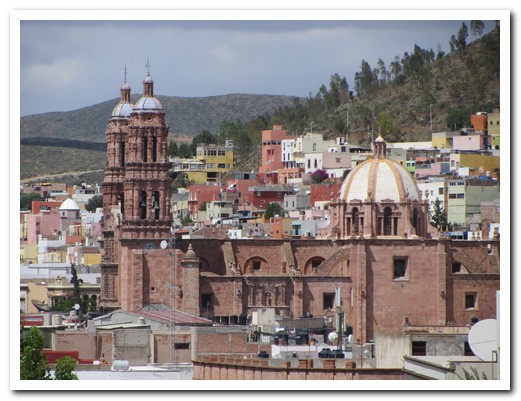
Zacatecas Cathedral
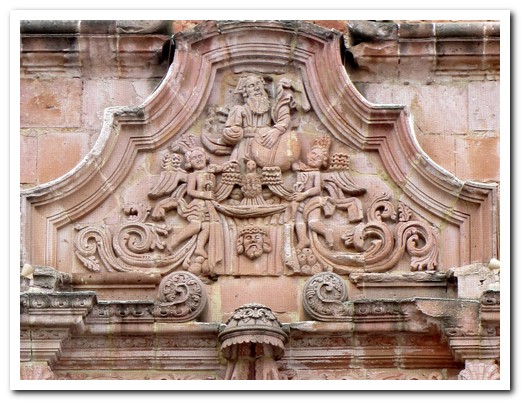
Carving on the Cathedral side doorway
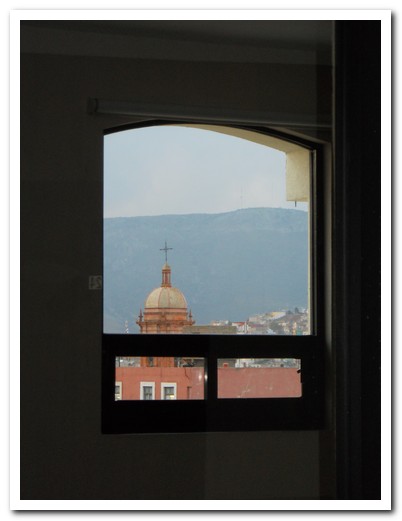
Church dome through the window of Terrasse Hotel
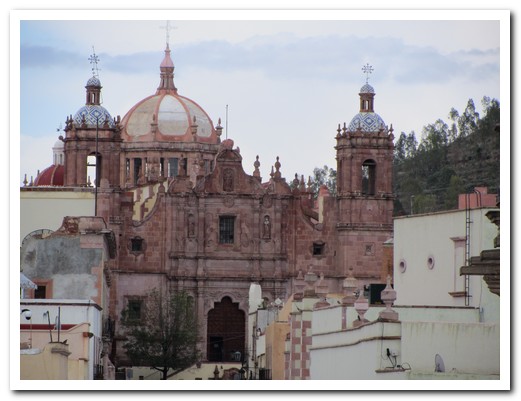
Templo de Santo Domingo, formerly Jesuit
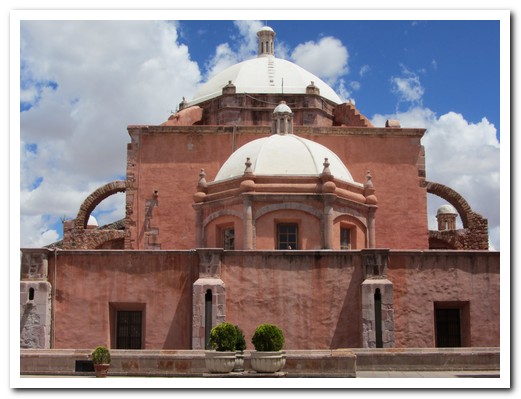
Templo de San Agustin
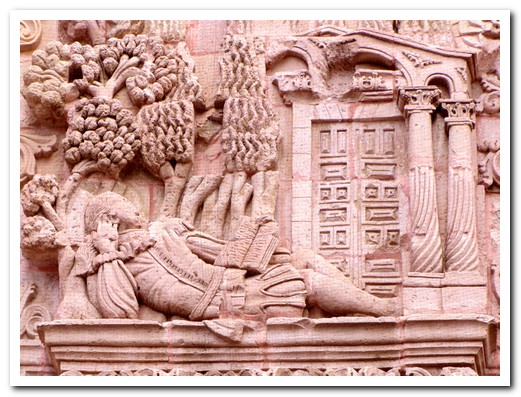
Detail above the side door of Templo de San Agustin
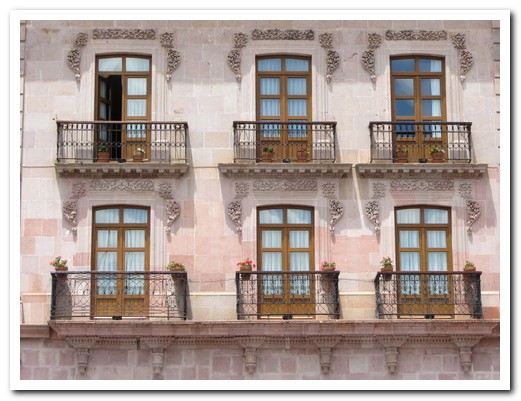
Balconies in the pink stone
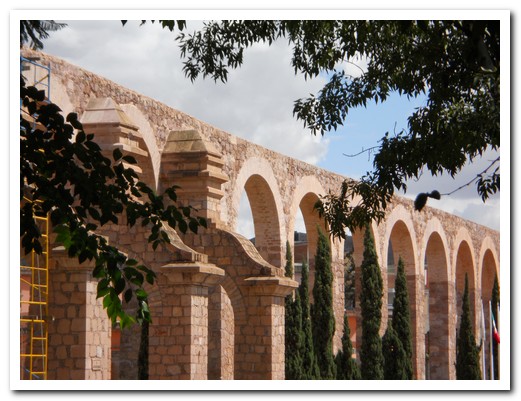
Aqueduct

Old pink stone theatre - Teatro Calderón
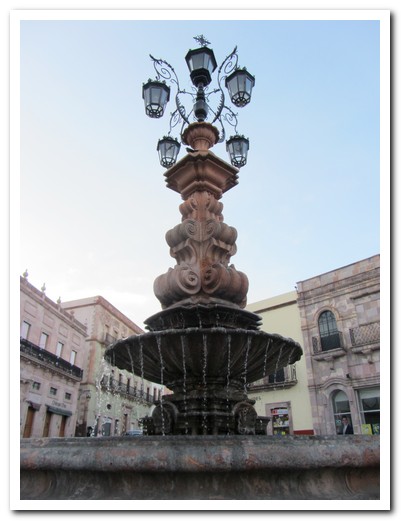
Fuente de los Faroles (fountain of the street lamps)
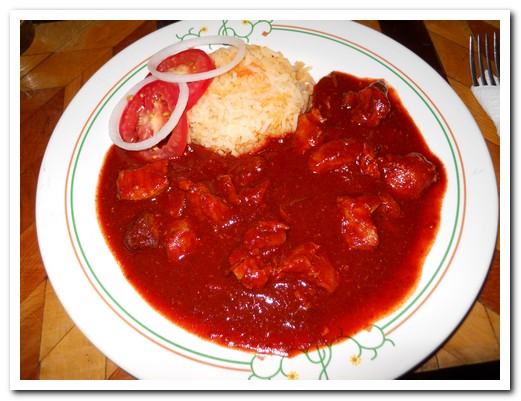
Assado de Boda from nearby Jerez - pork with oranges, chocolate, chilli and spices
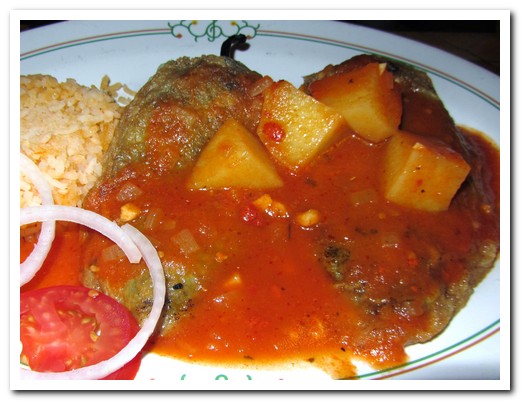
Zacatecas stuffed chillies
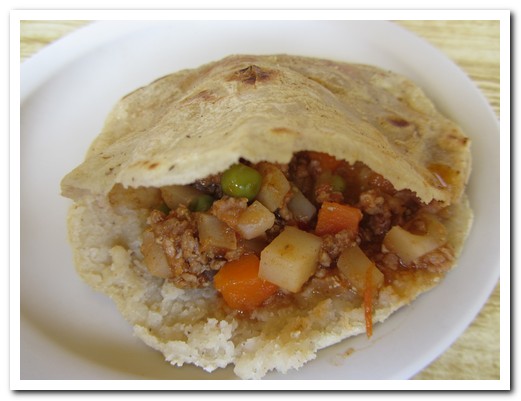
Gordita (Fatty) - stuffed tortilla
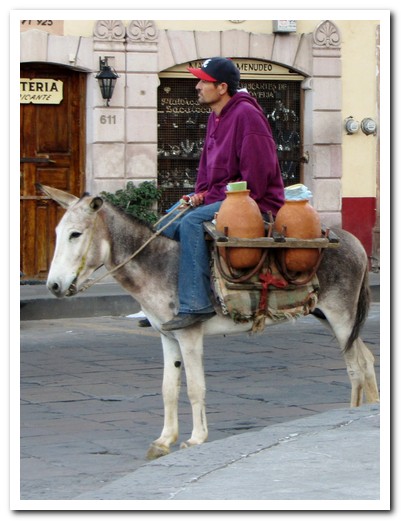
Donkey bringing honey wine made from cactus to town
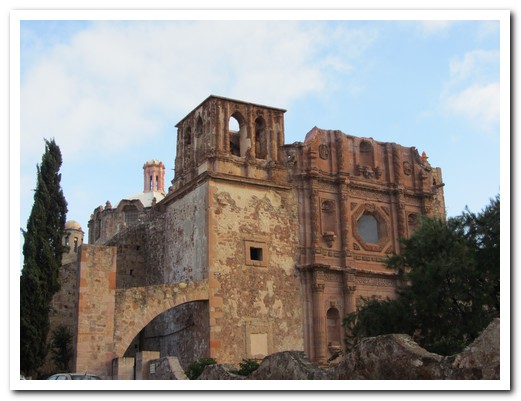
Ruins of ex-Convento San Francisco
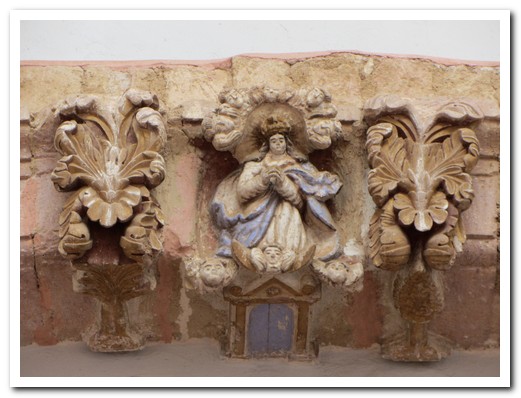
Detail of the ceiling of the Convento
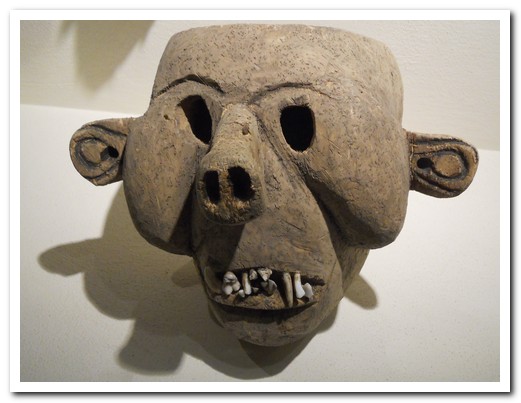
There are 3000 ceremonial masks ...
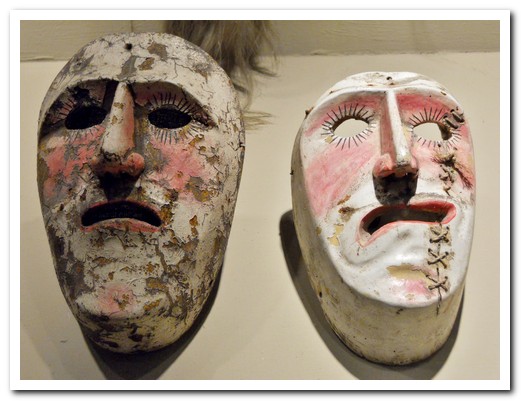
... in the Museo Rafael Coronel
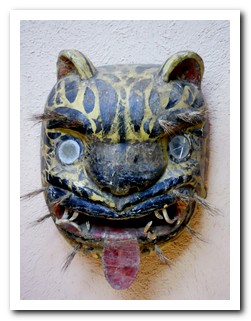
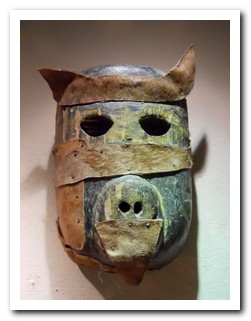
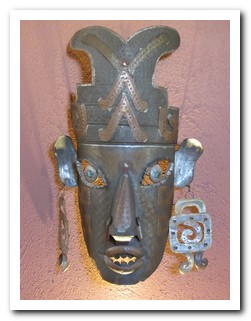
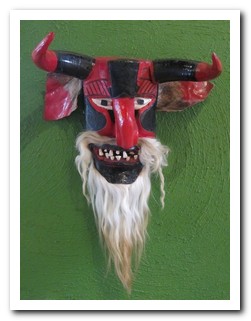
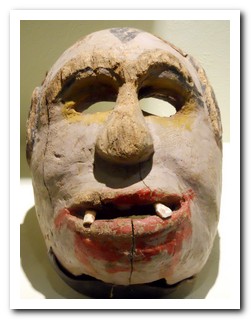
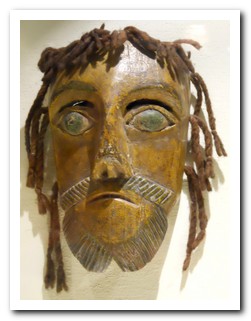
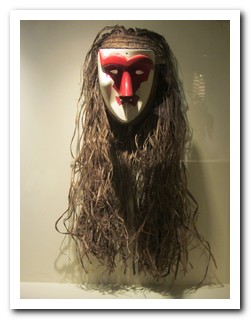
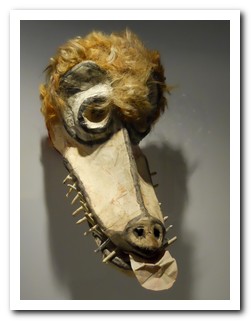
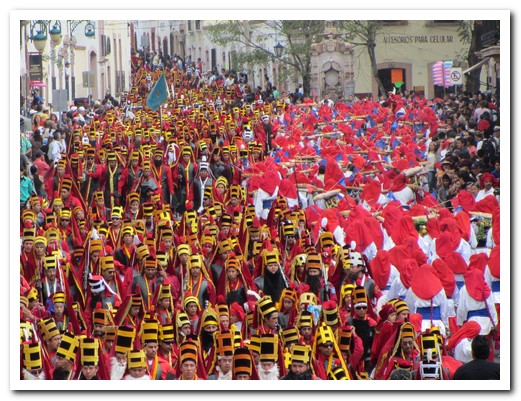
11,000 people, dressed as Christians and Moors, filled the streets
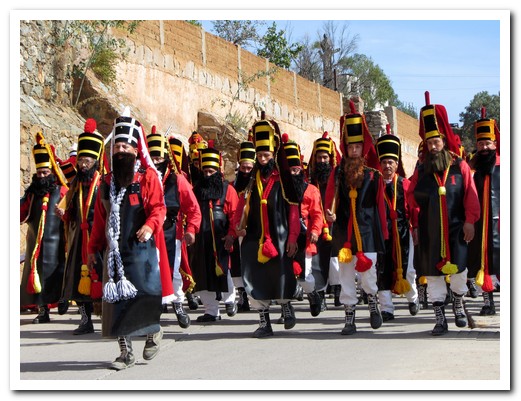
The Christians march ...
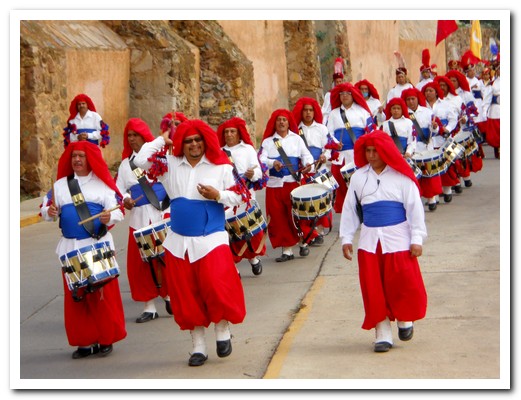
... followed by the Moors ...
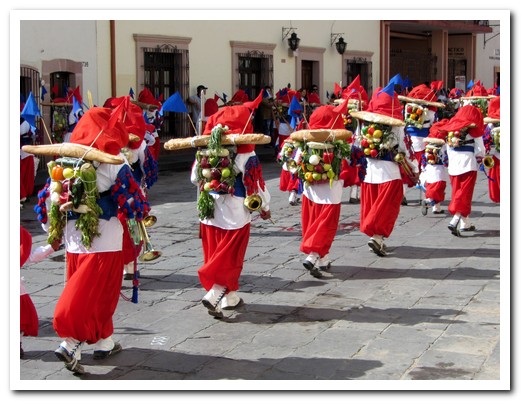
... off to battle with their provisions on their backs
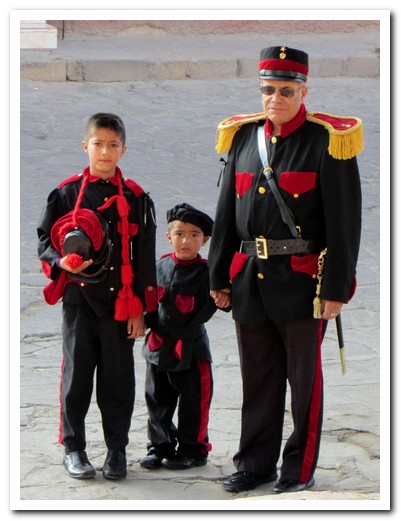
The whole family gets involved
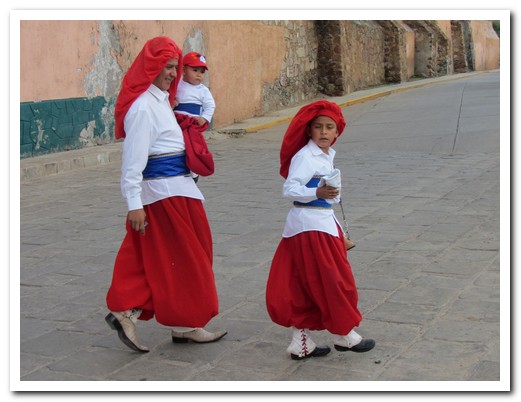
A family of Turks goes to the battle
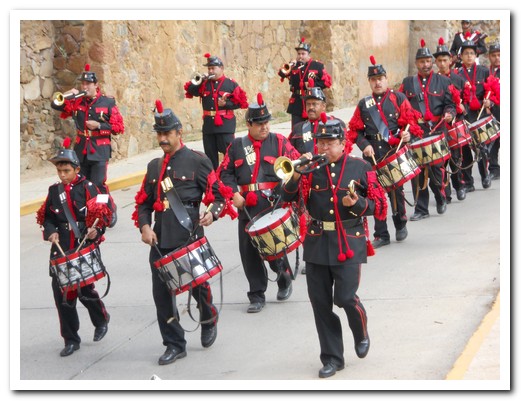
Christian drummers
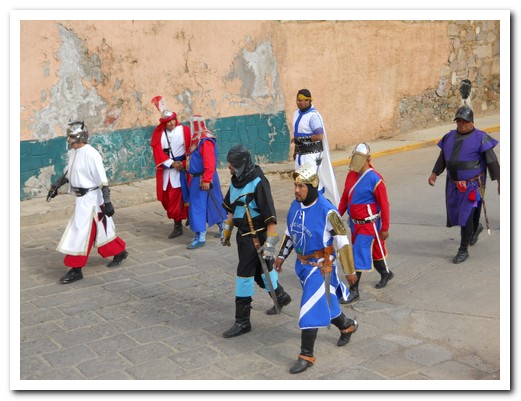
Charlemagne´s knights
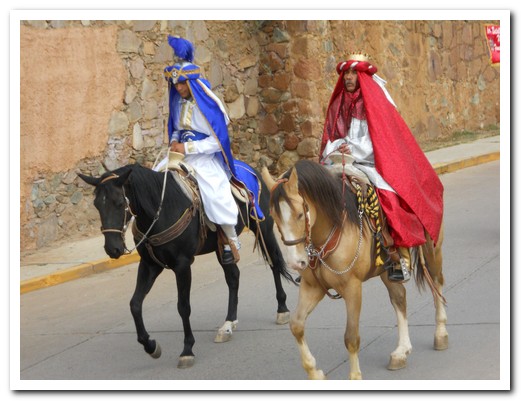
Charlemagne´s horsemen
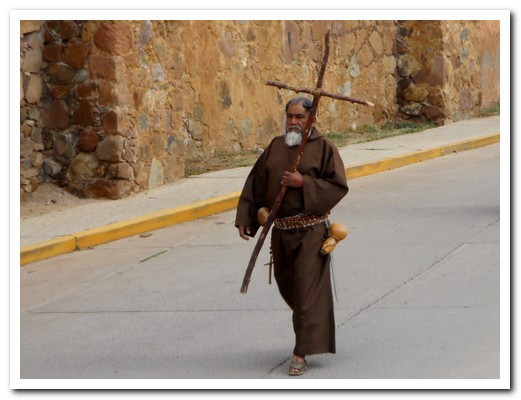
Friar
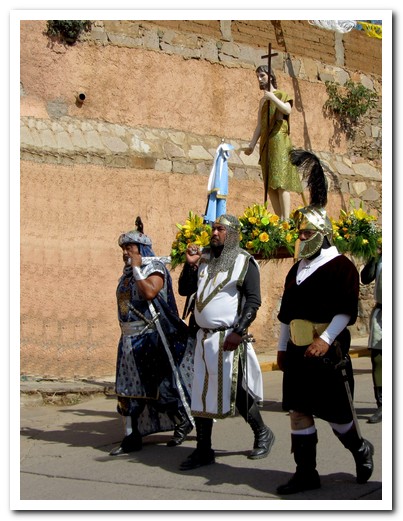
Statue of John the Baptist
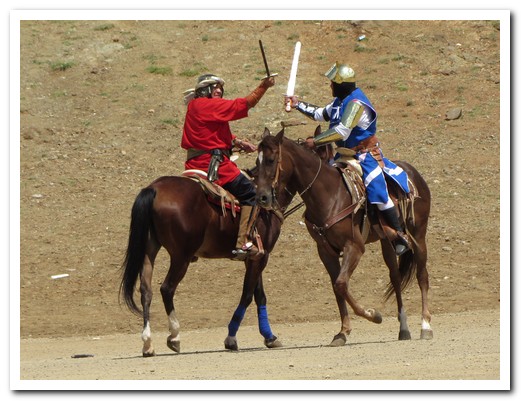
Let the battle begin
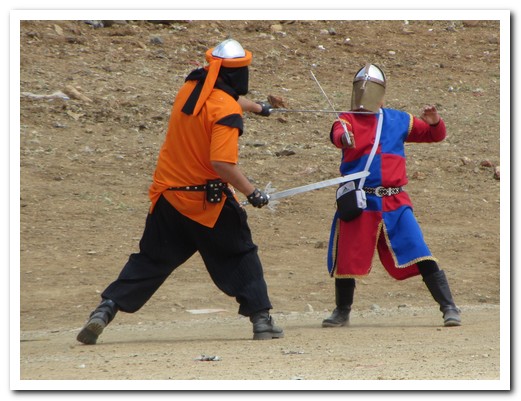
Two soldiers in the battle
Las Morismas de Bracho 2011
29th August 2011
Here is a short movie of Las Morismas de Bracho 2011 in Zacatecas.
.
Aguascalientes & San Luis Potosí
25th August 2011
Aguascalientes [26] was called the Perforated City by the Spanish when they arrived here in 1575 because of the many unexplained catacombs, not open to the public today. The 18th century Baroque cathedral which sits on one side of the large Plaza de la Patria is just one of the many colonial churches in the city. The Museum of Death shows Mexico´s interest in death right back to pre-Hispanic times.
.
.
San Luis Potosí [27], an important silver mining town in colonial times was founded in 1592. It was named after the fabulously rich Potosí in Bolivia and its patron saint is Saint Louis, King of France from 1234 to 1270. The Spanish laid out a grid town plan with many parks and plazas. Today it is a delight with most of the historic centre pedestrianised. Many churches and beautiful public buildings from the 17th to 19th centuries remain in use.
.
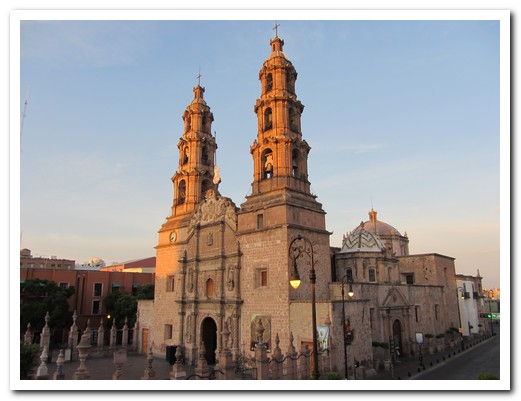
Aguascalientes´s Cathedral
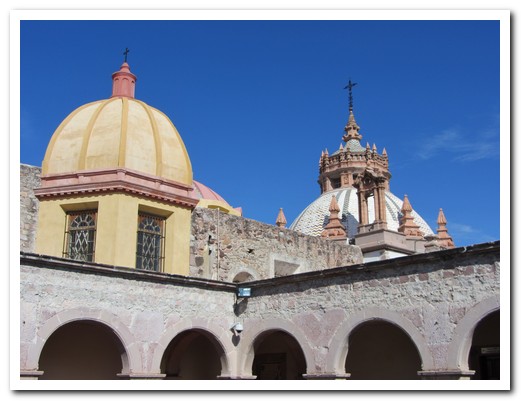
Church domes
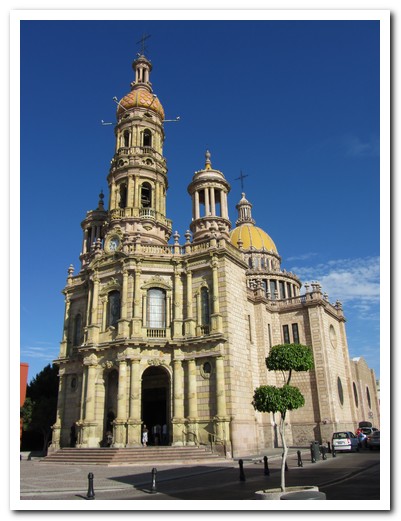
Templo de San Antonio
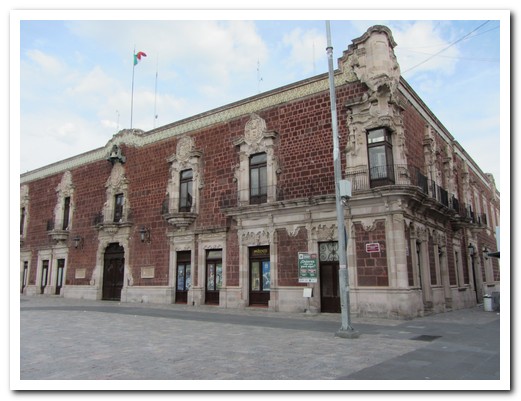
Old Town Hall of Aguascalientes
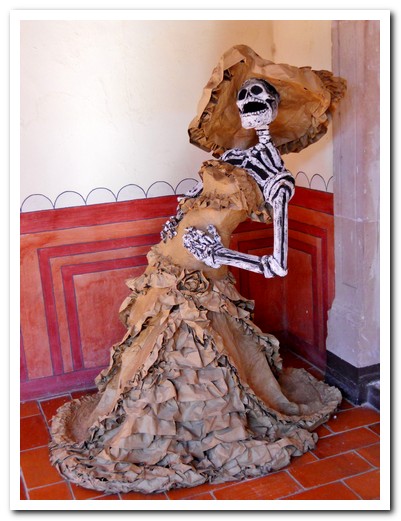
In Mexico there is a different attitude to death ...
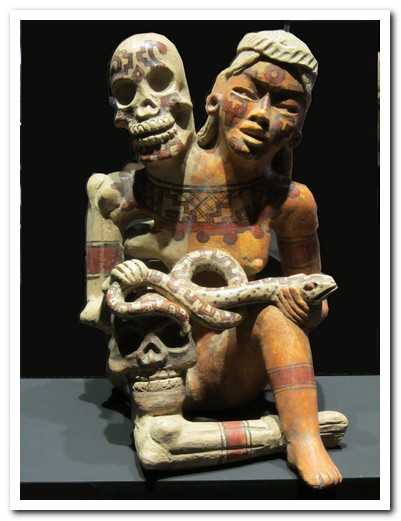
... from pre-Hispanic to modern times ...
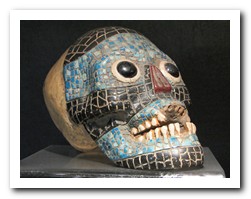 |
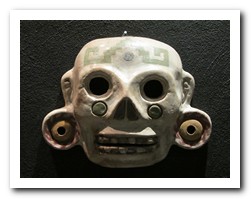 |
| … as displayed in the Museum of Death in Aguascalientes |
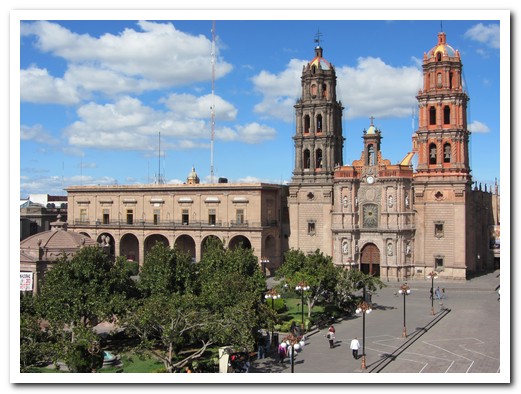
Cathedral San Luis Potosí
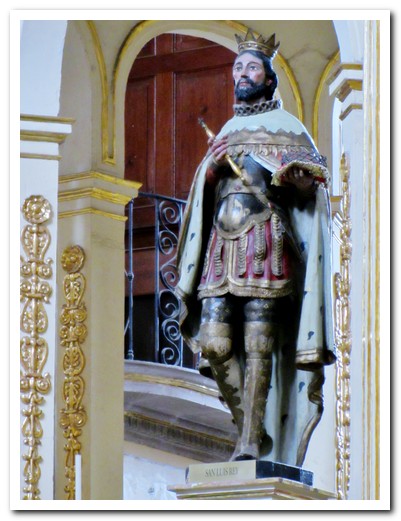
Statue of Louis IX, patron Saint of San Luis Potosí, on the altar

Jesuit Church and Loreto Chapel
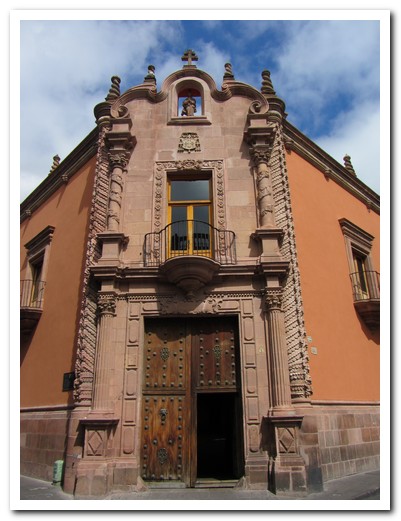
Royal Treasury building
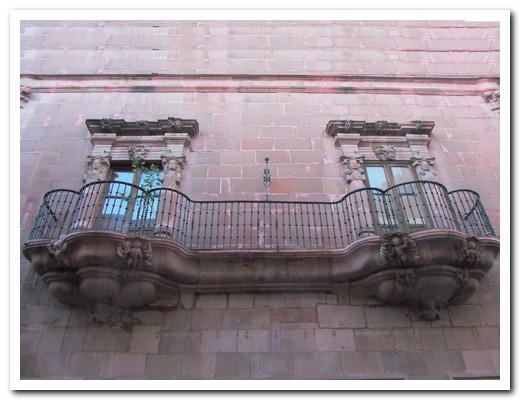
Balcony
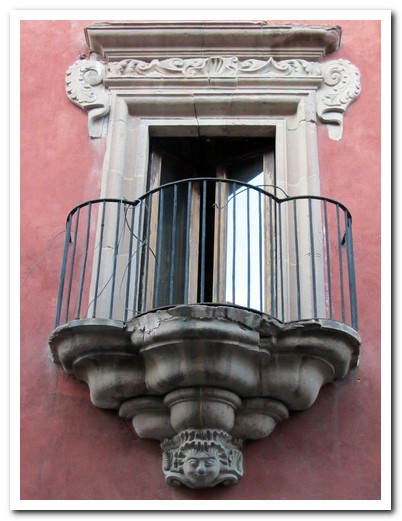
Another balcony
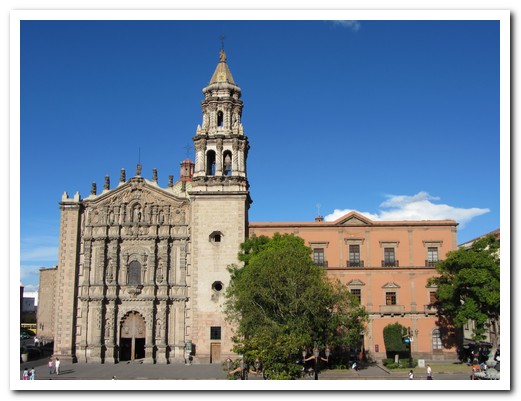
Templo del Carmen
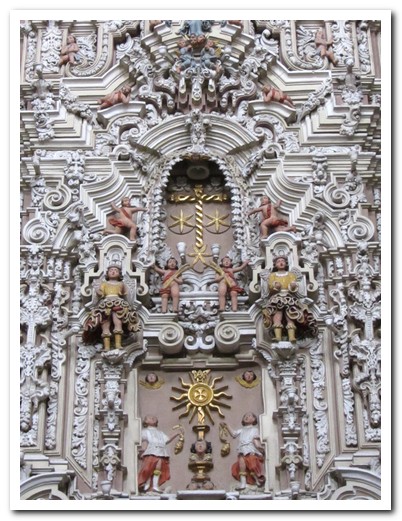
Elaborate carvings inside of Templo del Carmen

San Miguelito
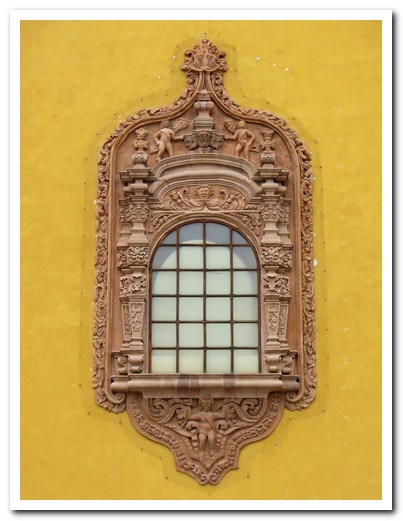
Decorative window
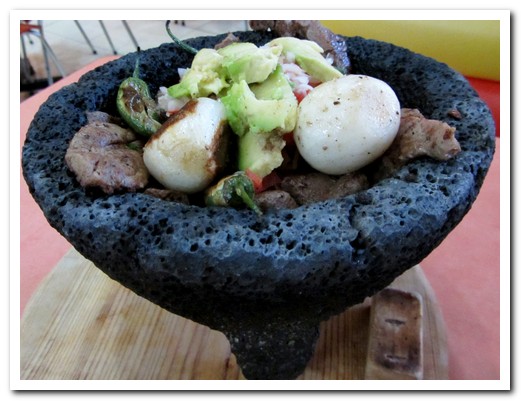
Molcajete - grilled meat, cactus, chillies, onions, avacado and cheese served in a stone mortar
Querétaro & Guanajuato
20th August 2011
Santiago de Querétaro [24] has a fine 74 arched aqueduct from 1726 that runs 1280 metres across a valley into the city. Founded in 1531, the Spanish laid out a grid style settlement while the native section retained a more haphazard arrangement. This unusual mix adds to the charm of the historical centre, bustling with people on the weekend.
.
Wine is produced to the northeast of Querétaro, but we found it impossible to find until we stumbled upon the tiny cafe Pluma Lounge where we enjoyed a bottle of white wine from nearby Ezequiel Montes with a selection of local cheeses and a loaf of homemade bread bought from the bakery next door. We finished off with coffee and chocolate, also local.
.
.
Founded in 1559, Guanajuato [25] is a smaller city built on several hills. One of the world´s richest silver mines in colonial times produced many lovely buildings and churches. Along the valley at the centre of the town there are 2 streets for cars, with several tunnels built in river beds underneath. Narrow twisting pedestrian alleys, interrupted by plazas and gardens, wind up the hills. It is easy to get lost. Balconies almost touch in the Callejón Del Beso (Alley of the Kiss), the narrowest alley where lovers once kissed across the street. We stayed at Casa de Pita, a knick knack filled house, with many levels, twists and turns, much like the city itself. Owner Pita is a generous bundle of energy and serves a great breakfast around the table in her kitchen.
.
The Museum of Mummies is the strangest place. Because of the number of burials, the local cemetery followed the old Spanish custom of exhuming and cremating bodies after five years. Dozens of bodies were disinterred between the late 1800´s until the 1970´s. But instead of skeletons, the cemetery workers found the bodies naturally mummified due to the dry conditions and stored them. Most of the mummies have their eyes and mouths open as if they were screaming. It is eerie.
.
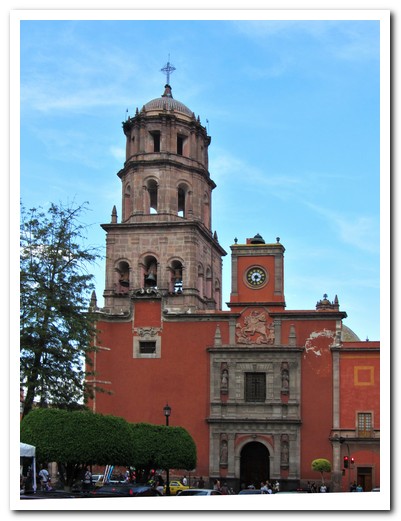
Querétaro – Templo & Ex-Convento de San Francisco …

… with Santiago the Moor Slayer on the facade
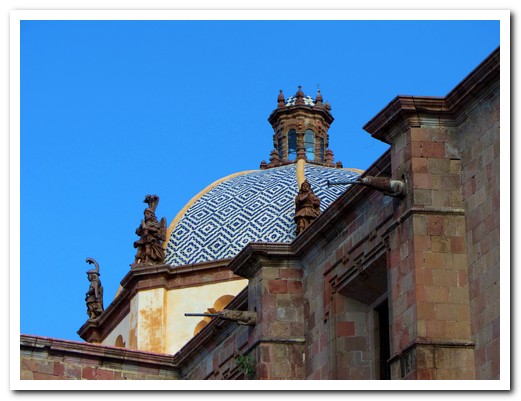
Dome with an indian angel on Templo & Ex-Convento San Agustin …
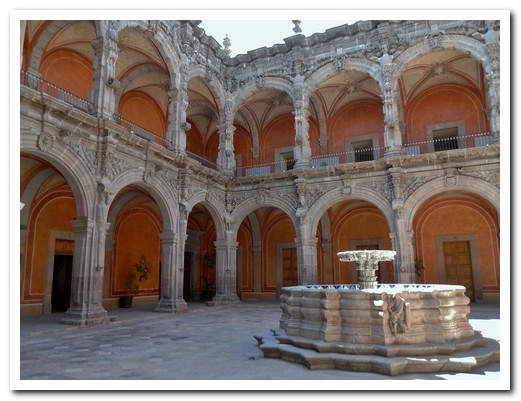
… Its courtyard is one of the most magnificent in Latin America
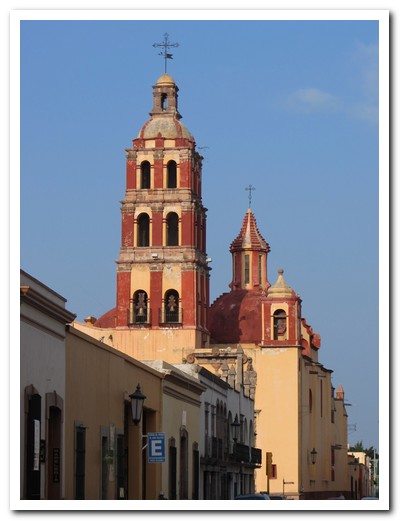
Convento & Templo de Santo Domingo (1692)
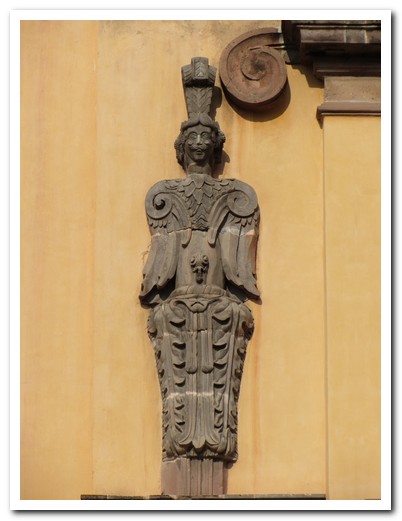
Indigenous looking angel on the front of Santo Domingo
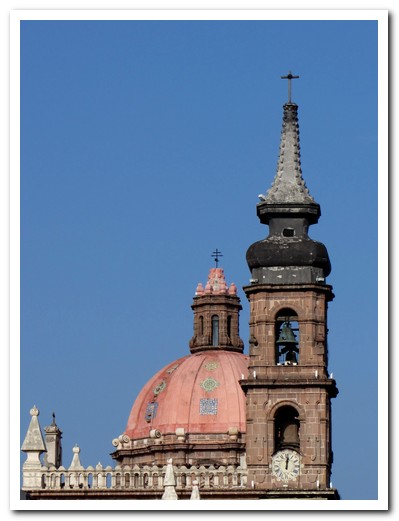
Pink dome of Sana Rosa de Viterbo
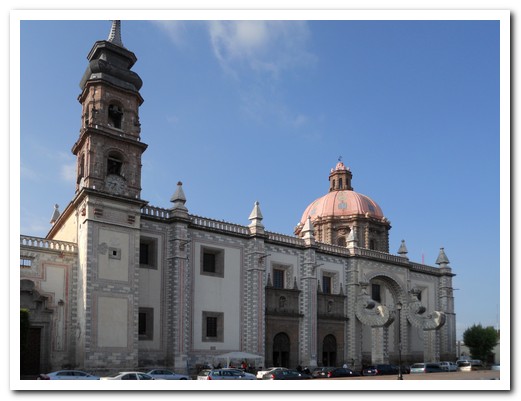
Elaborate Baroque front of Santa Rosa

Tiled dome of Santa Clara de Jesus (1633)
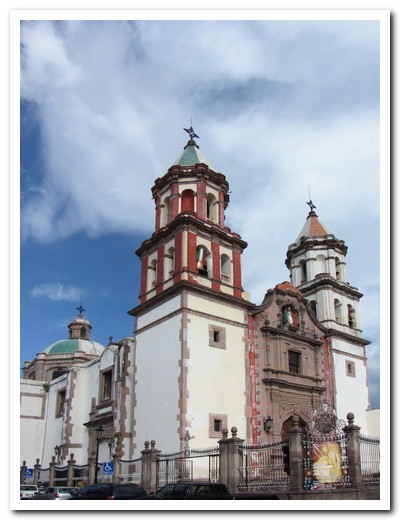
Church of Guadalupe
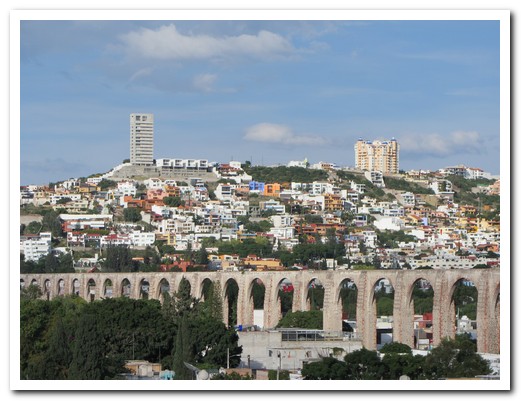
Querétaro´s aqueduct (1726) has 74 arches and is 1280 meters long
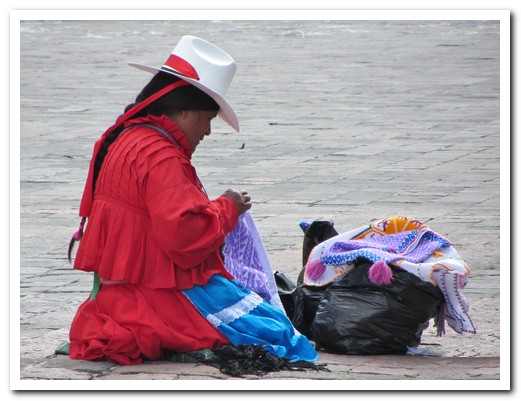
Local lady preparing clothes for sale in Querétaro
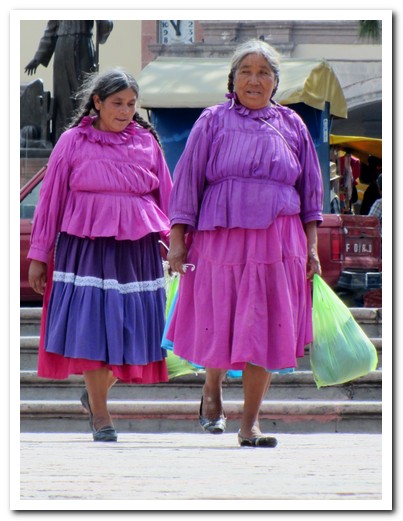
Two ladies
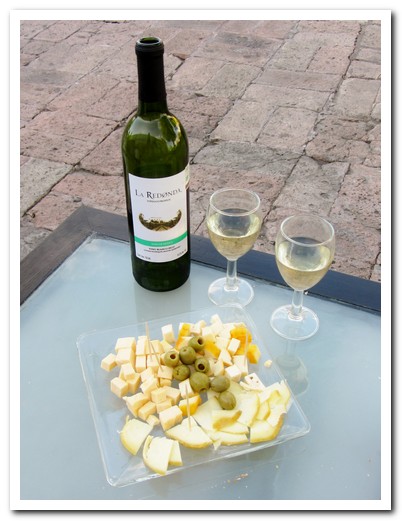
Querétaro wine and cheese at the Pluma Lounge
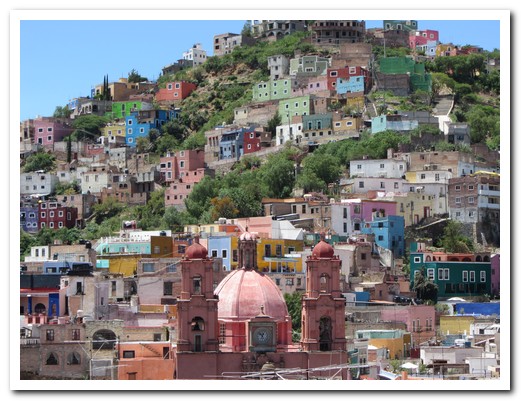
Guanajuato …
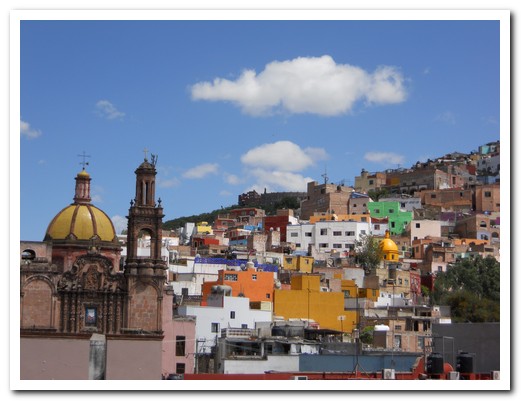
… is built on several hills
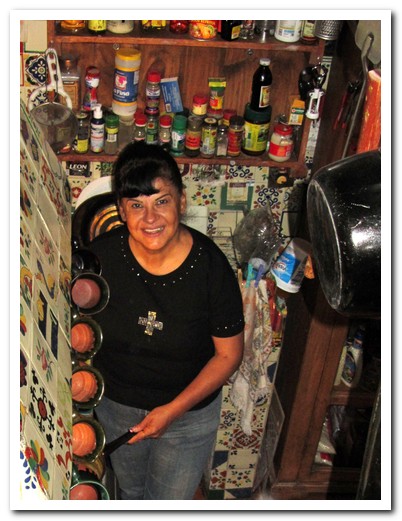
Pita, the friendly owner of Casa de Pita where we stayed in Guanajuato
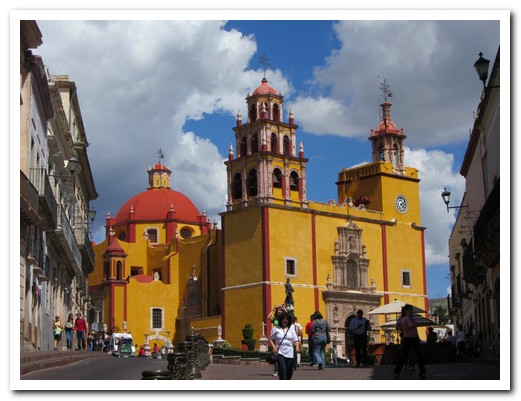
Guanajuato´s Basilica
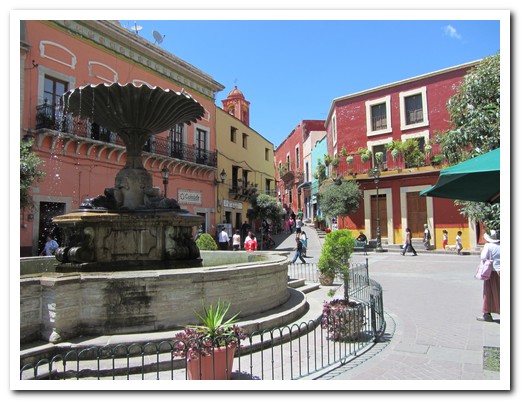
A pretty Plaza
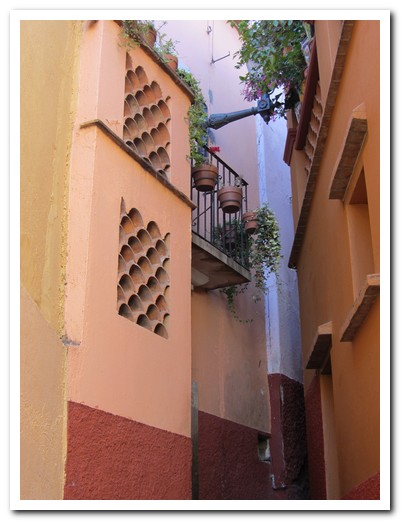
The narrow Callejón Del Beso (Alley of the Kiss)
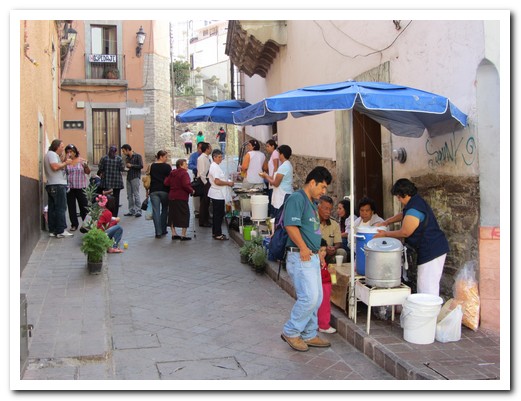
A popular street food stall
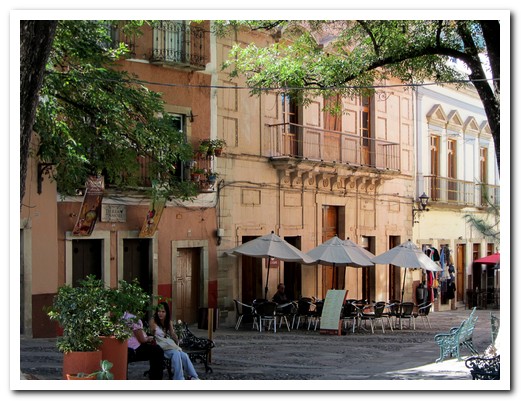
One of many leafy plazas in Guanajuato
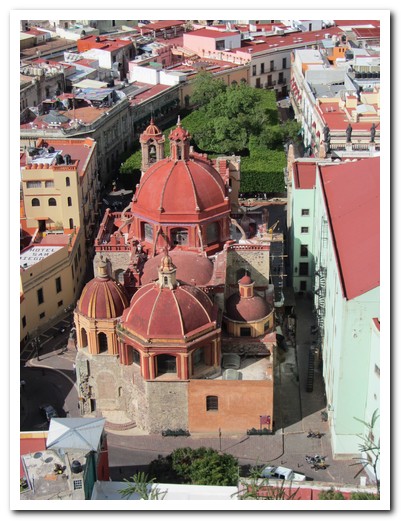
Templo de San Diego
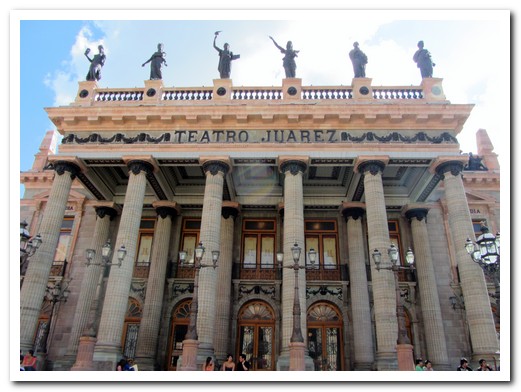
Theatre Juárez
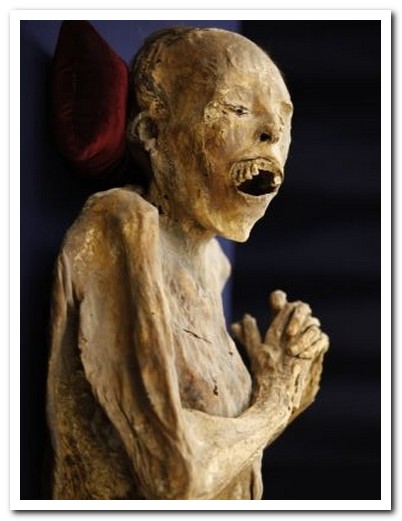
One on the mummies in the Museum in Guanajuata
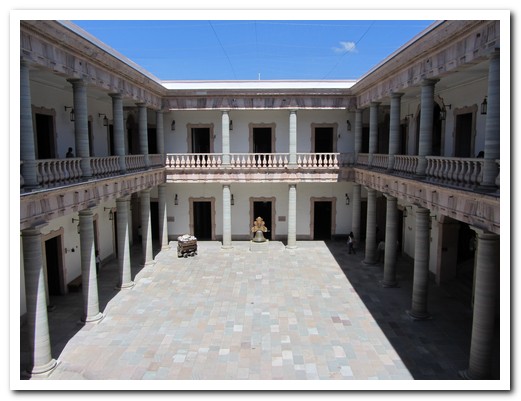
Alhóndiga Granaditas (grain storage) site of the first rebel victory in the war for independence
Hidalgo State
14th August 2011
For a little slice of England in Mexico, head to Pachuca [21] (90 k northeast of México City) with its hills covered in colourful buildings. Miners from Cornwall came here in the 1800´s bringing with them the game of soccer and Cornish pasties. There is a variety of fillings. At Pastes Kikio´s, we went for the potatoes and mince (and chillies) fillings and tried the chicken with red mole (sauce), but there are shredded chicken with frijoles (refried beans), frijoles with Spanish sausage, rice pudding or pineapple jam fillings. Each one costs under $1. A short bus ride away is the old mining town of Real del Monte, another Pueblo Mágico, with cobbled streets and red roofed buildings.
.
To the south are the imposing Toltec ruins of Teotihuacán [22] – The City of the Gods – once the capital of Mexico´s largest empire with pyramids to the sun and moon. The city was built between 150 AD and 600 AD but around 900 AD it was abandoned. The Aztecs who later visited it believed it was here that the gods sacrificed themselves to set the sun and moon in motion. Today it is visited by thousands on day trips from México City. We stayed overnight at a hotel nearby so we could be there for the 7 am opening and avoided the crowds.
.
At the smaller archaeological site near Tula [23] (900 AD to 1150 AD) 4 large basalt warrior figures over 4 metres tall once held up the roof of the Quetzalcóatl Temple. Fine carvings remain around the outside. In the 11th century, Toltecs emigrated from Tula and settled at the former Mayan city of Chichén Itzá (500 kilometres away). We were constantly reminded of the similarities between the two sites – the ball courts, human sacrifices, the jaguar sculptures, the Chac Mools (reclining human figures with a tray over the stomach – meaning /use unknown) are virtually identical.
.
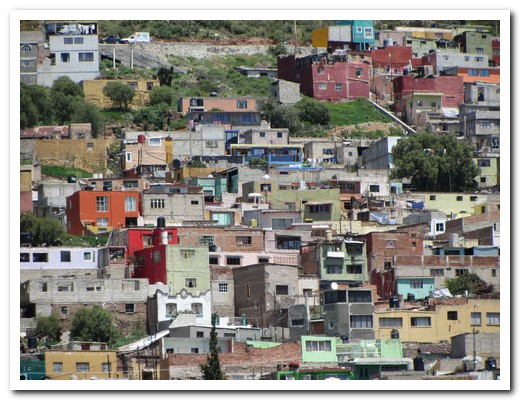
Puchuca has brightly coloured houses built up the hill
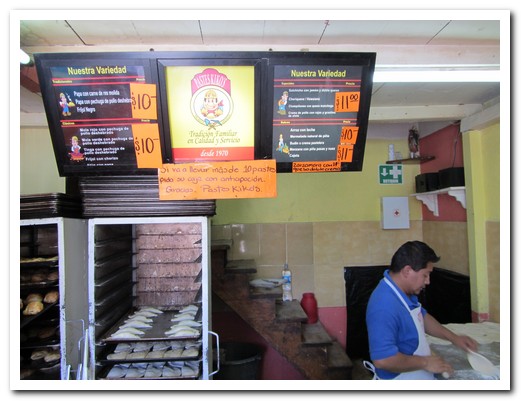
Many pastie choices in Pachuca
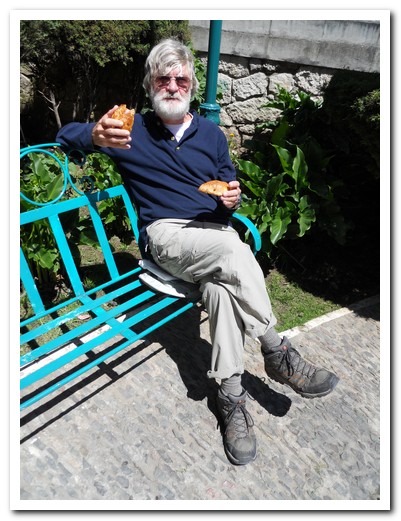
Jeff tries a couple of pasties
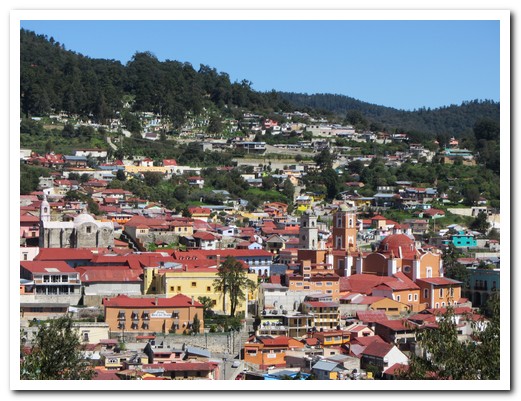
The old mining town of Real del Monte at 2600 meters

The huge Sun Pyramid at Teotihuacán has the same size base as the Great Pyramid in Egypt
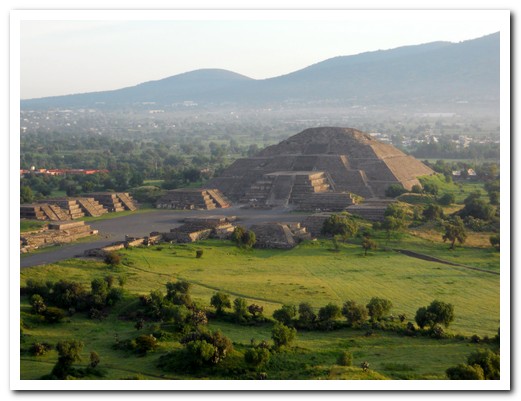
Pyramid to the Moon

Puma mural
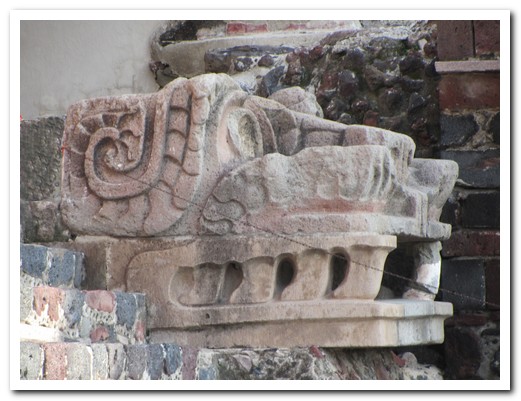
Jaguar head
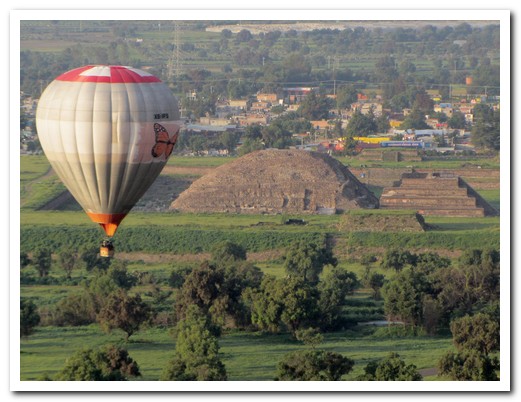
Hot air balloon floating past La Ciudadela (The Citadel)

Temple of Quetzalcóatl
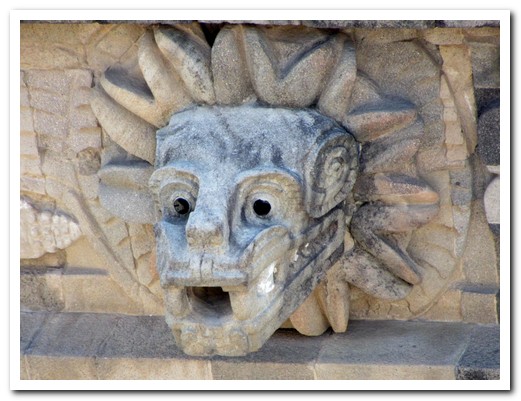
Feathered serpent
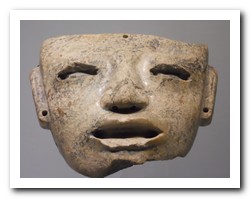 |
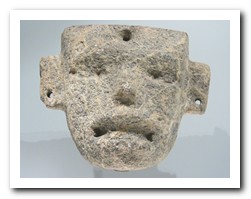 |
| Stone funeral masks |
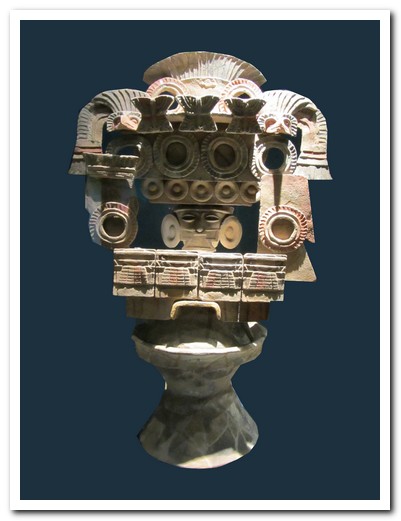
Incense burner
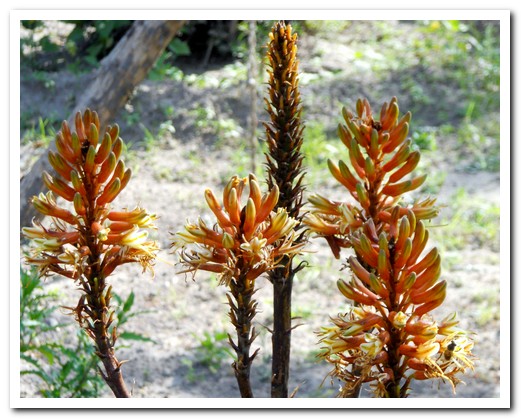
Cactus flowers
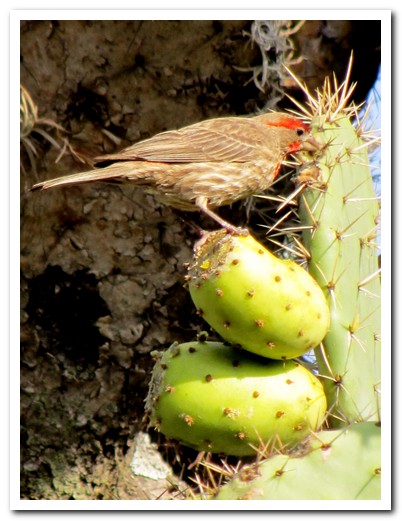
Little bird feeding on a cactus
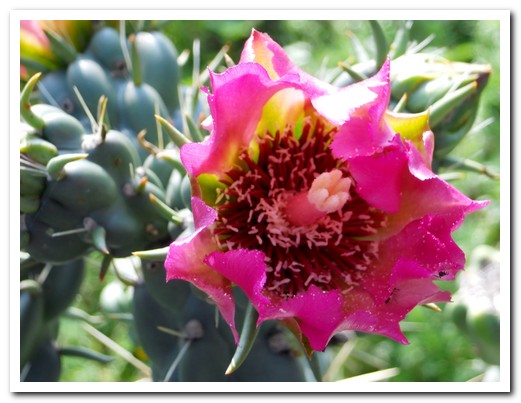
Cactus flower
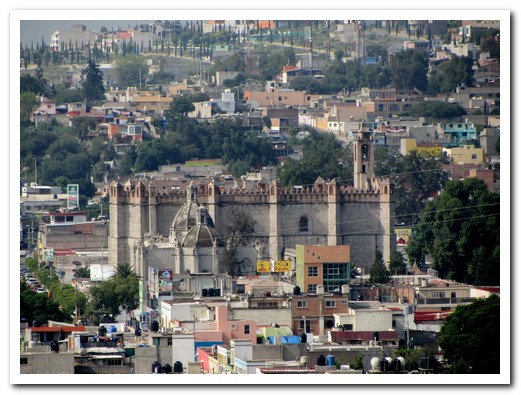
Tula´s fortress like Cathedral, former Monastery (Franciscan, 1550)
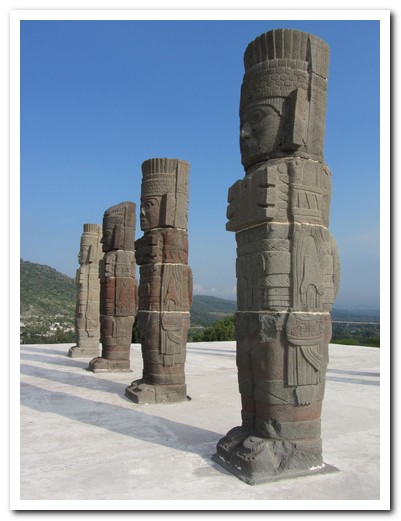
4 warrior figures ...
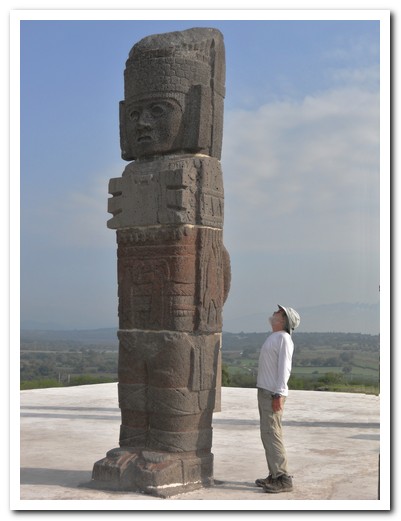
... 4.5 meters high ...
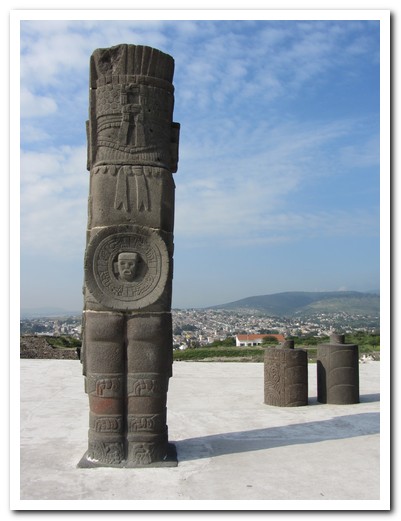
... now facing towards the south ...
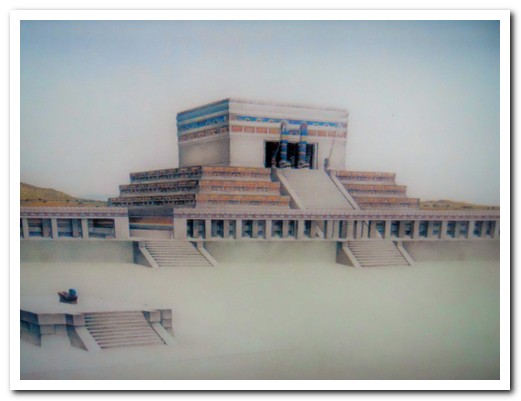
... once held up the roof of the Temple of Quetzalcóatl (Feathered Serpent)
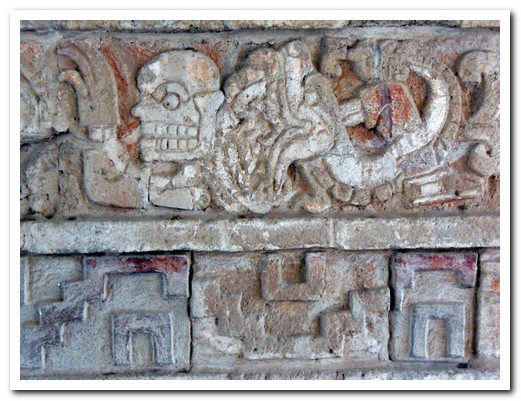
Carvings of humans devoured by enormous rattlesnakes surrounded the Temple
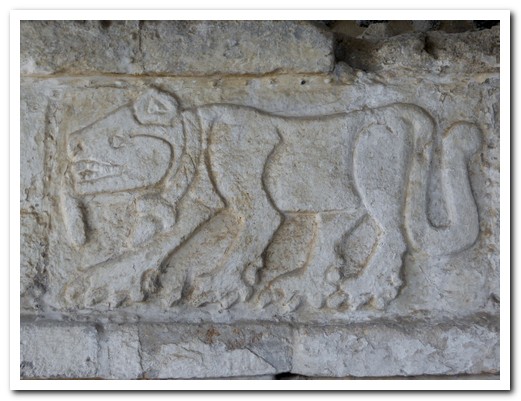
Captive Jaguar eating a human heart (similar to Chichén Itzá)
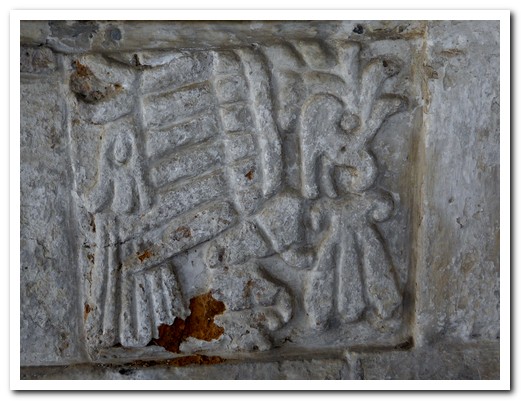
Eagles ...
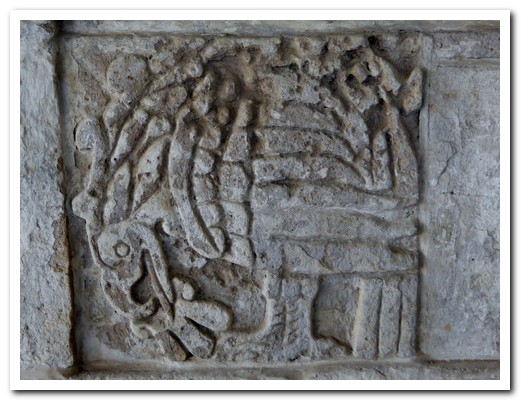
... eating sacrificed humans
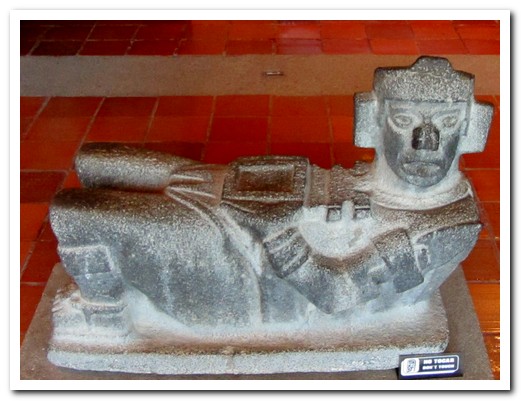
Chac Mool (now in the site´s Museum)
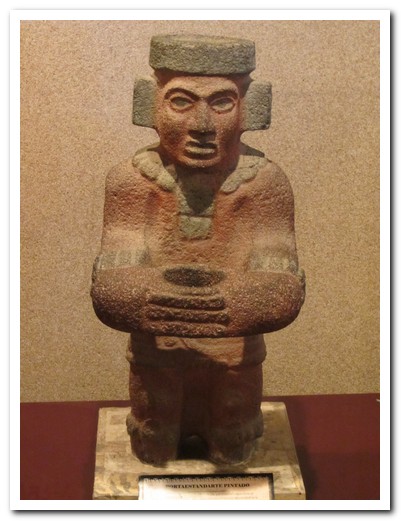
Statue

Carved figure of a man carrying a bundle
Papantla & Cuetzalan
10th August 2011
Papantla [19] is the centre for vanilla production and stopping off point for the ruins of El Tajín, the Totonac capital from around 600AD to 1200AD. We were excited to see the Voladores (Flyers) in front of the church. This ancient Totonac rite, originally to help break a drought, is performed by 5 men wearing bright ceremonial clothing to represent birds. While one dances and plays a flute on top of a pole 40 metres above the ground the other 4, tied at the waist by a rope, fall gracefully and fly to the ground revolving around the pole forming a pyramid shape. It is truly a spectacular sight. We never tired of watching them. Click here for a short video.
.
We were lucky to be in Papantla for the International Indigenous Pueblo day when bands played and the town swelled with people dressed in their finest.
.
A 3 hour bus trip up into the mountains on a rough rocky road bought us to the remote Cuetzalan [20], one of Mexico´s pueblos mágicos. With its steep cobbled streets, overhanging roofs and vistas of the green hills, it really is magical when the mist and rain roll in. There is a market (tianquis) on Sundays when villagers in traditional dress arrive from the surrounding area. As luck would have it, we arrived for the weekend fiesta of song, dance and food. The local speciality cecina (smoked pork) and the forest fungus were delicious.
.
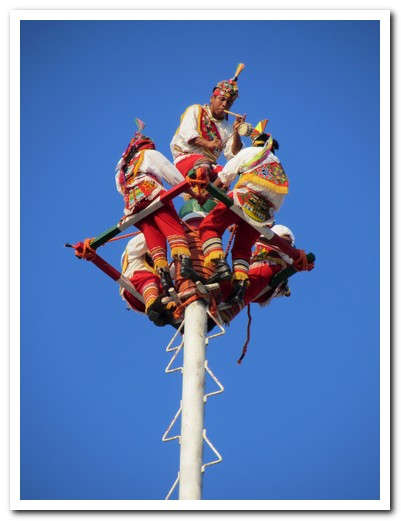
The Voladores (Flyers) of Papantla - one dances and plays a flute on top of a 40 metre high pole ...
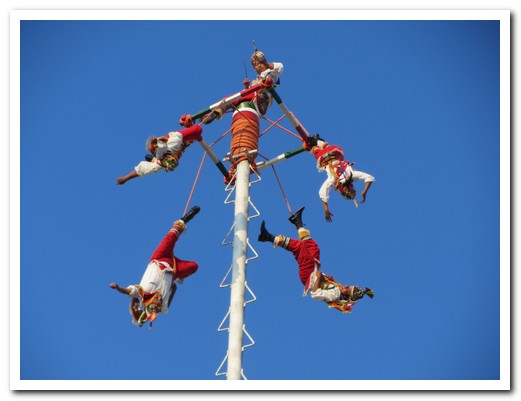
... while the 4 others fly off
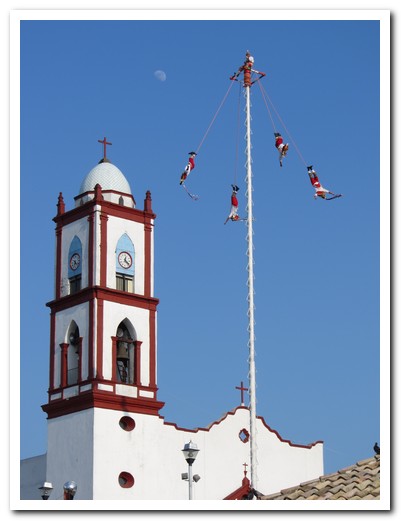
The pole is as high as the church steeple
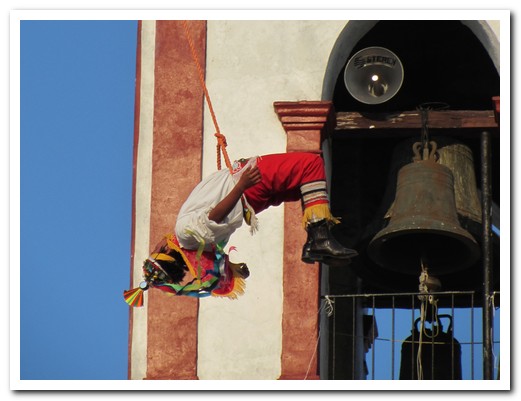
A Volador flies past the church bell tower
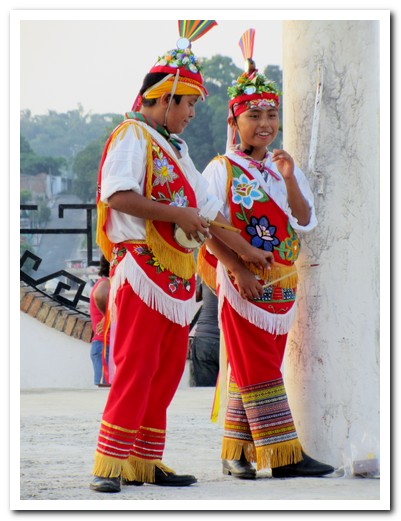
Voladores start young
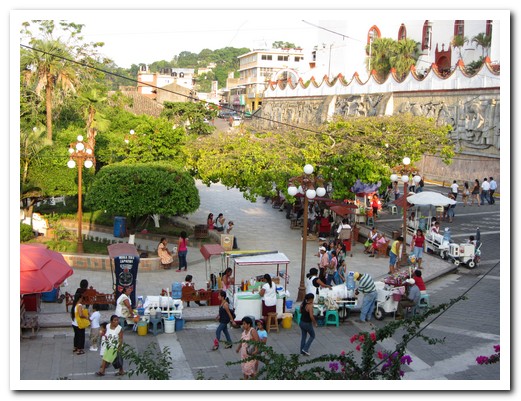
Food stalls set up around the plaza in Papantla
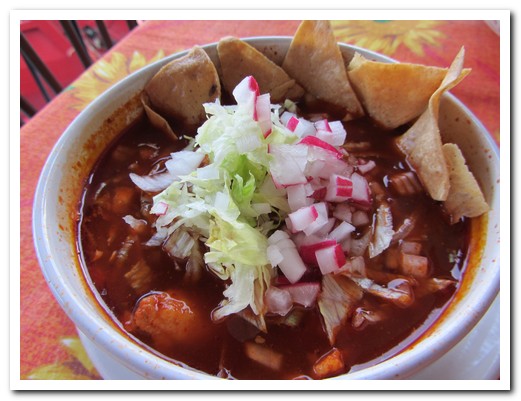
Pozole - pork soup with chilli, corn, lettuce, radish, onions and tortillas
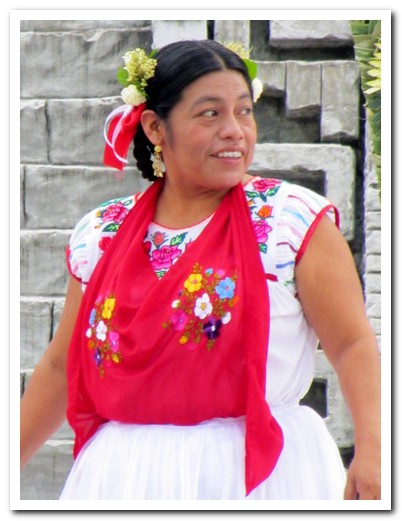
On International Indigenous Pueblos day, women ...
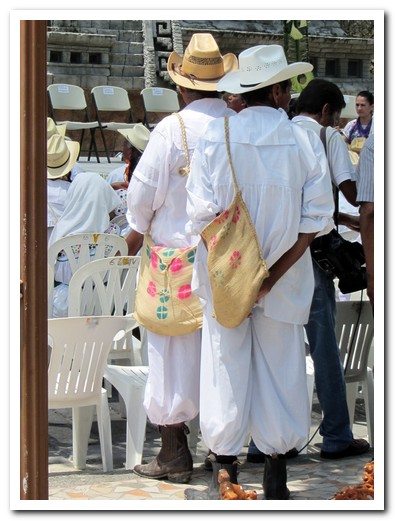
... men ...
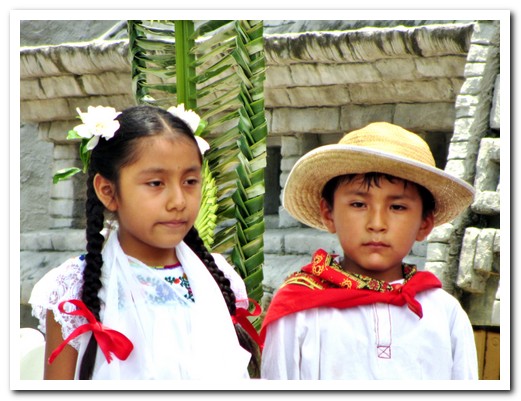
and children come to Papantla dressed in beautiful traditional clothing

El Tajín archaeological site
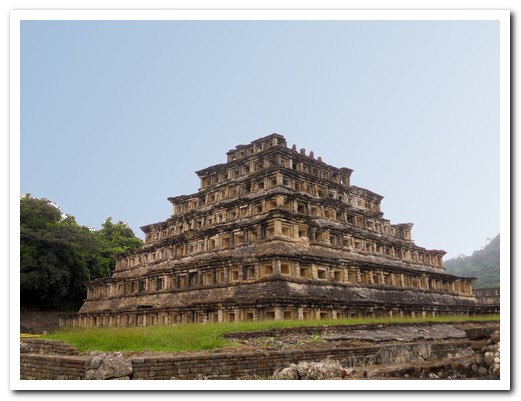
Pyramid of the niches
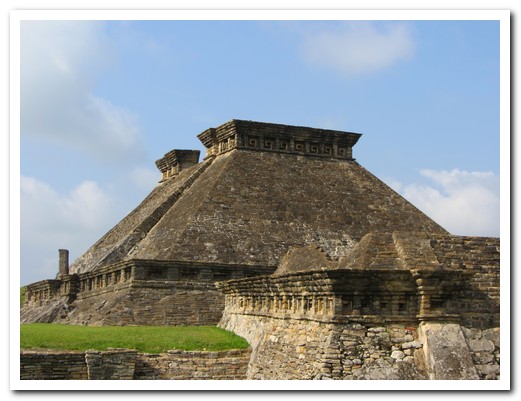
Another pyramid with ...
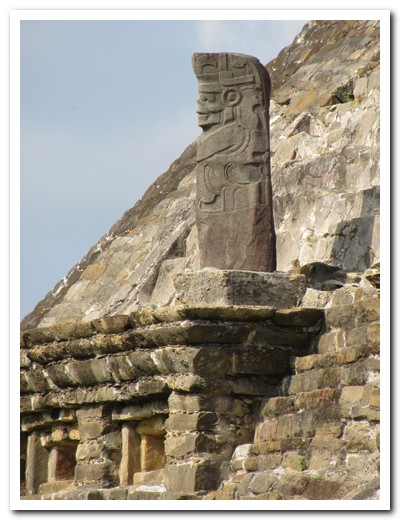
... carved stela of the God of Thunder and Lightning
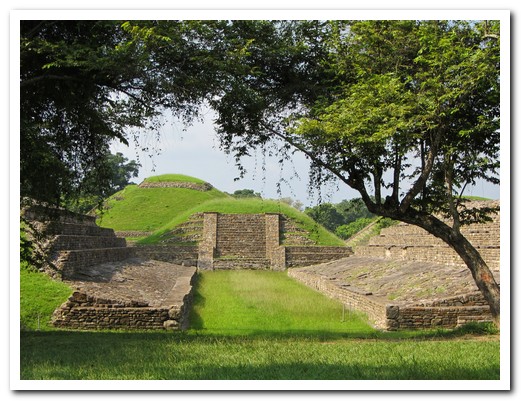
One of the 17 ball courts at El Tajín
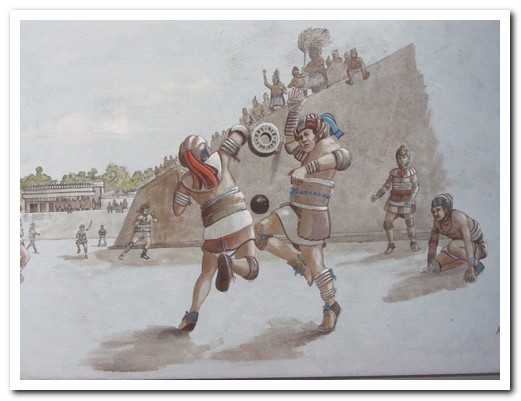
Painting showing the ancient ball game
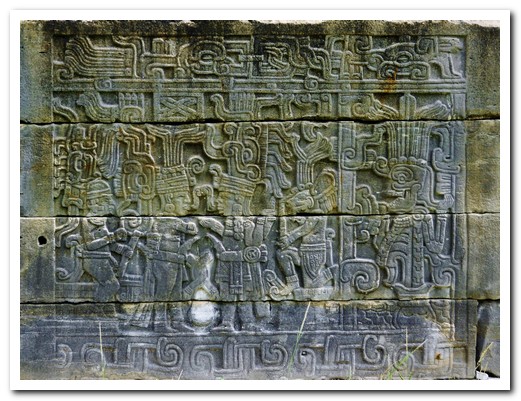
Carvings related to the ball game on one of the courts
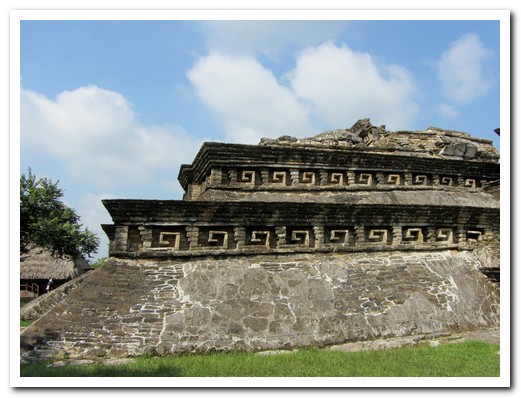
Fish hook decorations on a pyramid
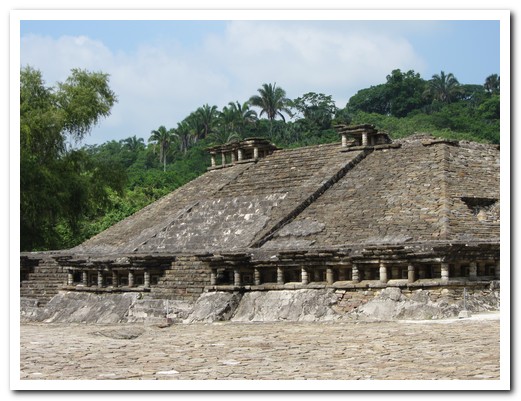
Columns feature on this one
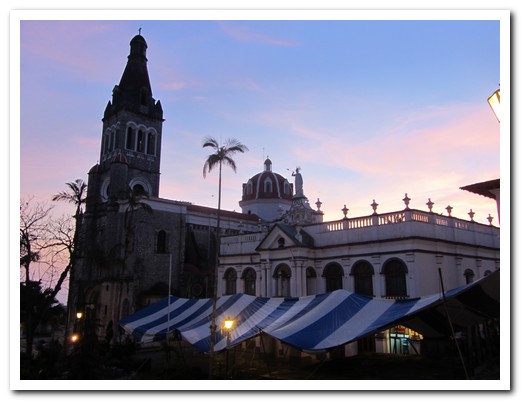
Cuetzálan Church with the tarp up for the festival
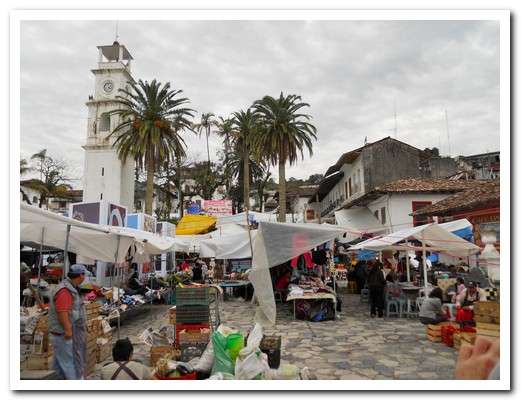
Sunday market at Cuetzálan
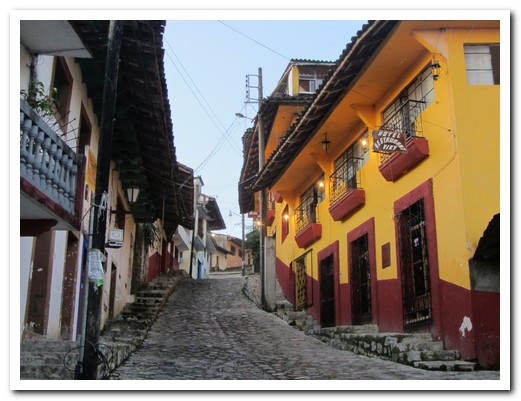
Steep cobbled streets
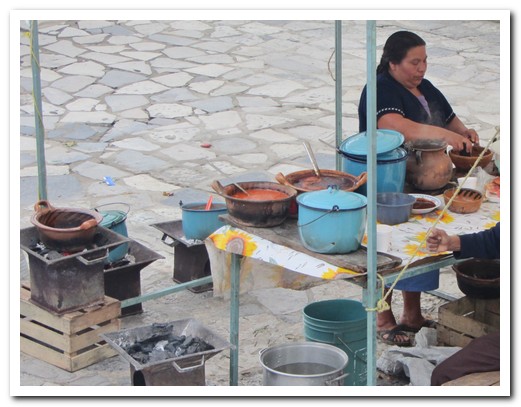
Food stall at the market
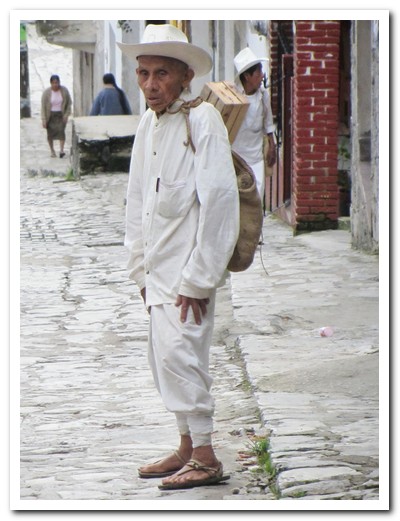
Traditional men´s dress
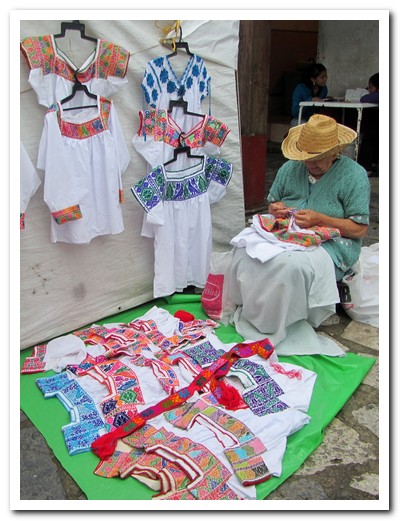
Lady embroiders blouses for sale
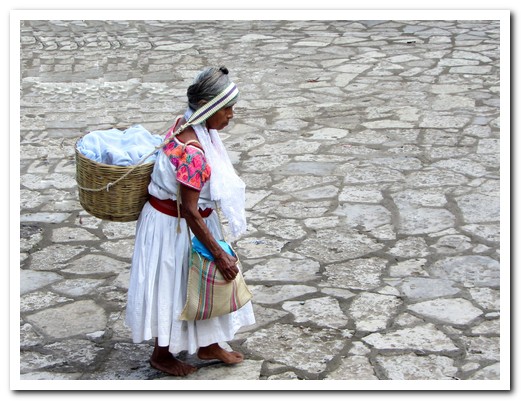
Typical ladies dress
Los Voladores (The Flyers) of Papantla
10th August 2011
Here is a short movie of Los Voladores (The Flyers) of Papantla. (There is no sound)
.
Xalapa
09th August 2011
Moving east towards the Gulf of Mexico, we stopped in Xalapa (or Jalapa) [18] the hillside capital of Veracruz State. On a clear day, Mexico´s tallest peak, snow capped Pico de Orizaba (5611 metres) can be seen from the central park.
.
We spent 4 hours in the excellent anthropology museum, moving through time in Vera Cruz from the original civilization, the Olmecs (1500 BC to 400 BC), through the Totonacs to the Aztecs in the years preceding Spanish conquest. The Olmecs, called the “Mother Culture”, are attributed with the erection of stelae, the jaguar cult and initiating the ball game. We were enthralled with the massive basalt Olmec heads, Totonac life sized raw clay figures, tiny toys with wheels and the 29000 other pieces.
.
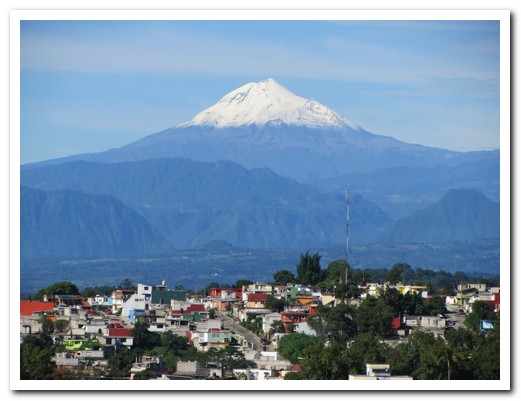
Pico de Orizaba (5611 metres) south of Xalapa
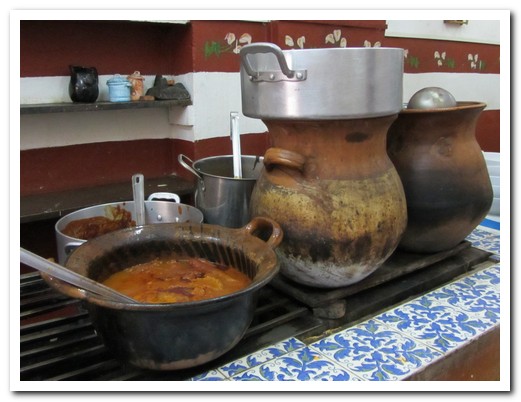
Pots of food bubbling away in La Fonda restaurant kitchen
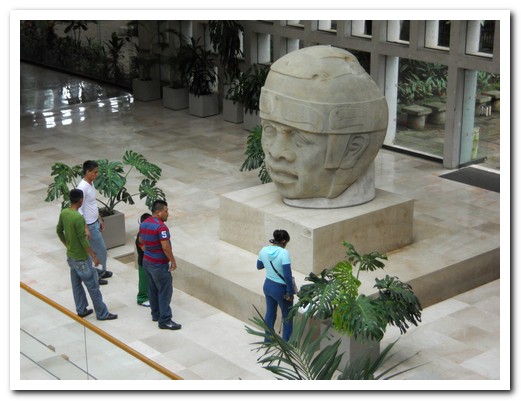
Large Olmec head in the Anthropology Museum
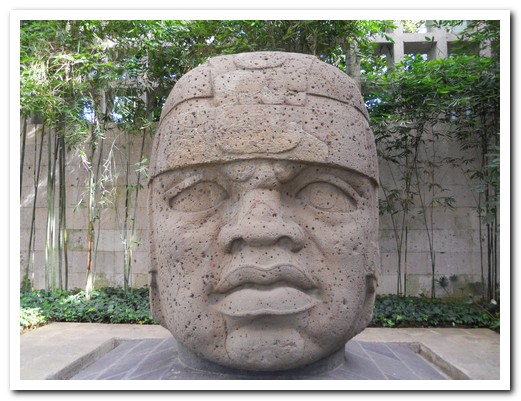
Massive stone Olmec head
 |
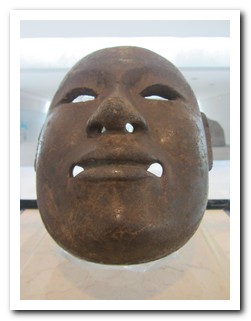 |
| Stone masks |
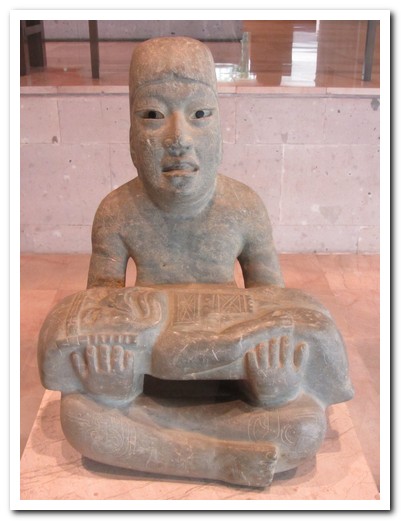
Greenstone Señor de las Limas with infant in his arms
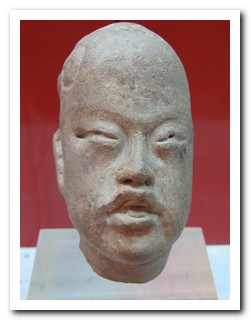 |
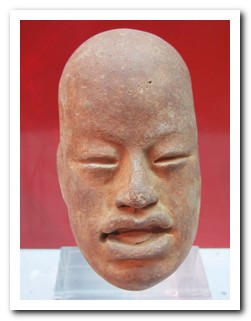 |
| Elongated heads and Asian features |
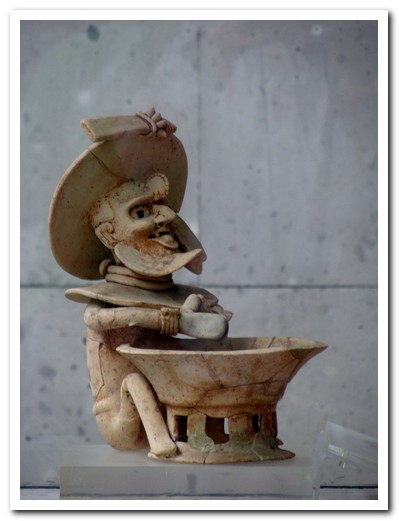
God of Fire warms his hands over a brazier
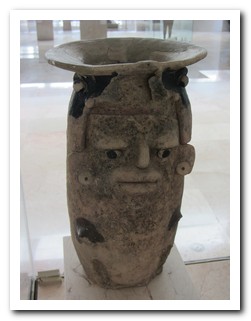 |
 |
| Vessels with faces |
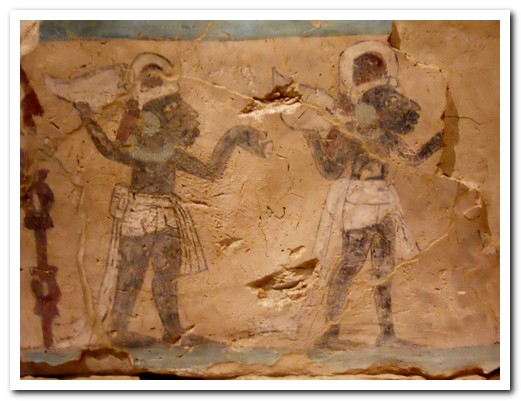
Part of a mural from the Las Higueras site
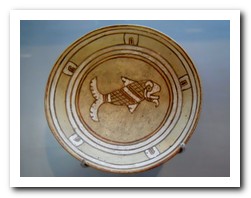 |
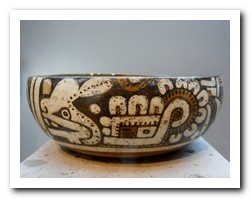 |
| Decorated plates |
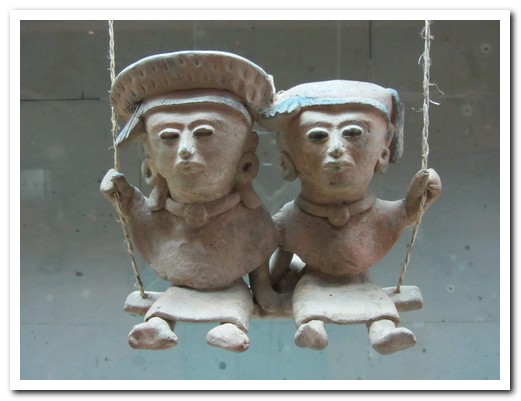
Two figures on a swing
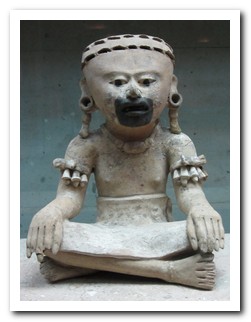 |
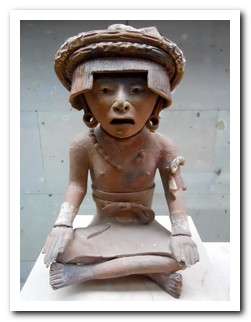 |
| Clay figures |
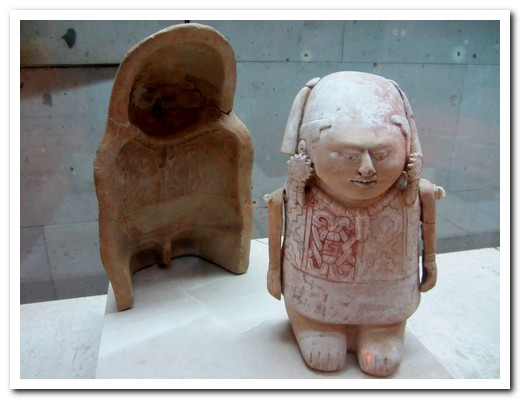
Figure with articulated arms, made in a mould
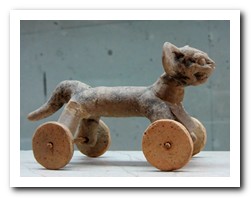 |
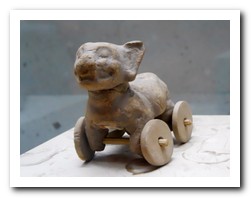 |
| These toys show pre-Hispanic people knew of the wheel |
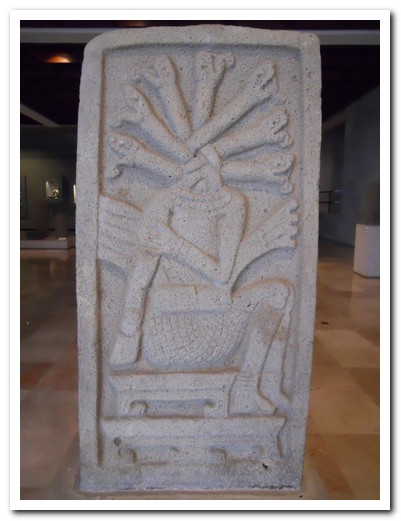
Decapitated ball player spurts snakes
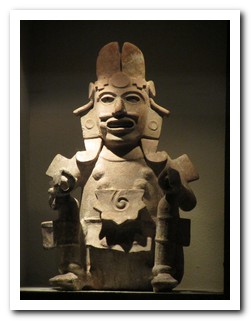 |
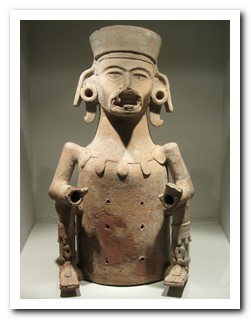 |
| Large clay figures |

Twins
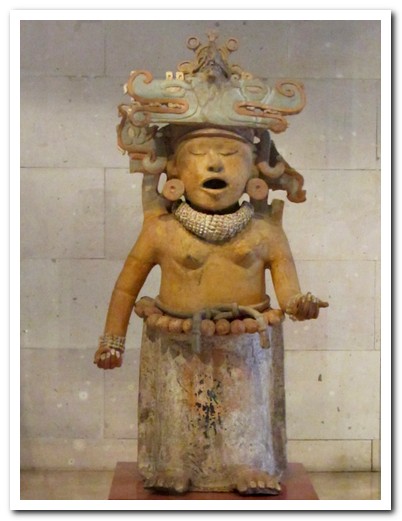
Life size clay statue of a woman who died in childbirth
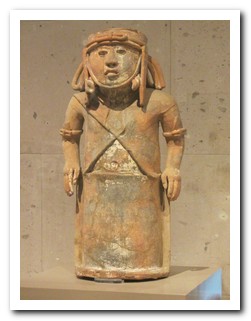 |
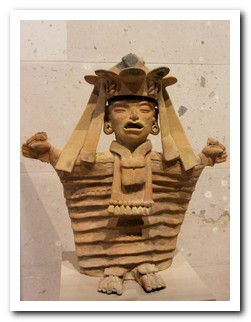 |
| Detailed clay figures |
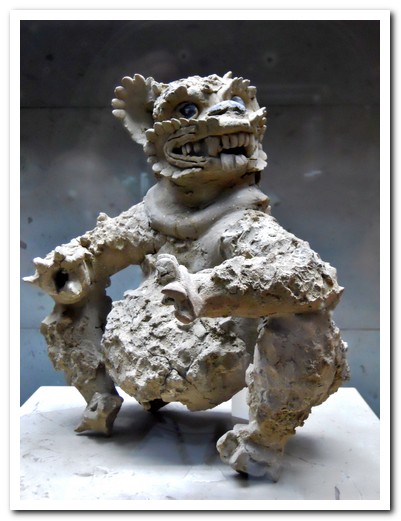
Jaguar
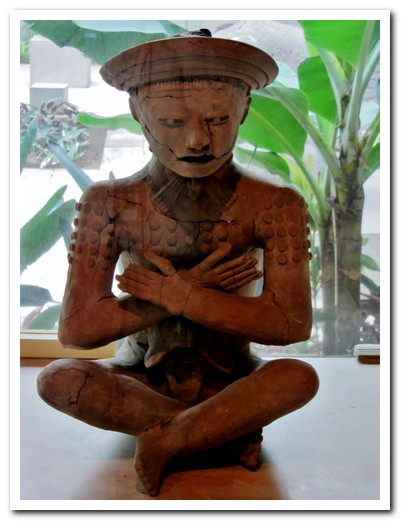
Cross legged clay figure
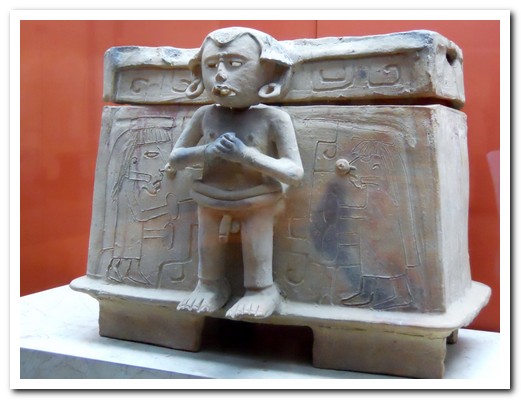
Cross eyed male figure with trunk
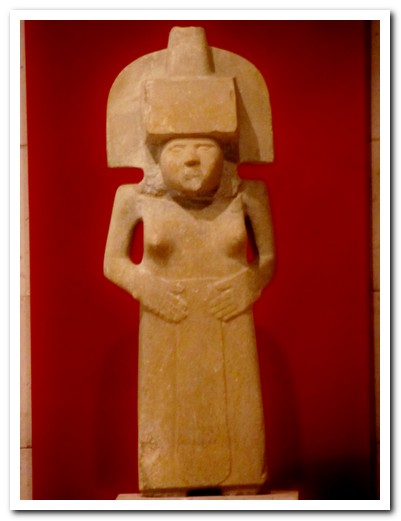
Statue of a female figure from northern Vera Cruz State
 |
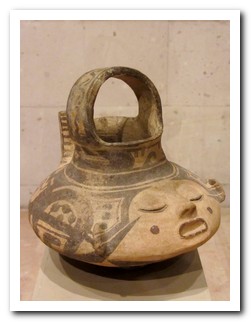 |
| Decorative vessels |
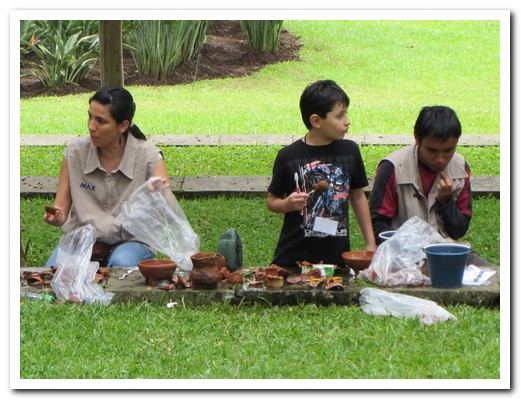
Summer school - kids fitting together shards of ancient pottery
Near Puebla
03rd August 2011
Cholula, south west of Puebla [16] was once a large Pre Hispanic religious centre dating from 500 BC. The original occupants disappeared around 600 AD and subsequent civilizations moved in and built over the existing pyramid. What appears to be a large hill in the centre of town was in fact the widest pyramid ever built, measuring 400 x 400 metres at the base. Atop sits the Santuario de Nuestra Señora de los Remedios from where the snow capped active Volcán Popocatepétl can be clearly seen. In 1519, here in the sacred city of Cholula, conquistador Hernán Cortés seized the Aztec leaders and 3 hours later at least 3000 Indians were dead and the city was on fire.
.
Tlaxcala [17], north of Puebla, and the warrior states surrounding it were once fierce allies of Cortés against the Aztecs. Today Tlaxcala is a pretty and quiet colonial town, worth a couple of days. The nearby site at Cacaxtla contains some of the finest frescos depicting battle scenes in vivid blues and reds. The frescos were preserved under layers of the pyramids and only discovered in 1994. On the next hill, pyramid Xochitécatl was the ceremonial centre. These cities peaked around 600 AD to 900 AD, but were abandoned by 1000 AD. At a nearby food stall we sampled the seasonal corn fungus on tortillas with barbequed cactus for lunch – we liked the earthy taste of the fungus.
.
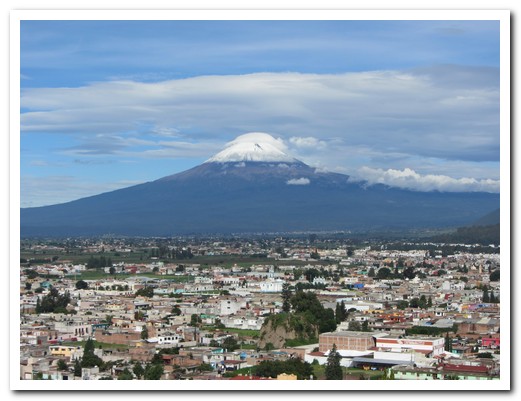
Active snow capped volcano Popocatepétl looms over Cholula
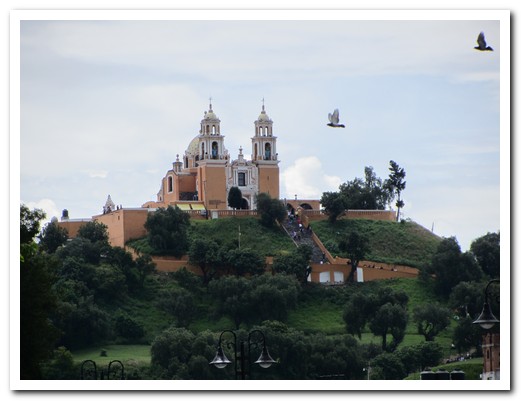
Santuario de Nuestra Señora de los Remedios sits on top of a huge pyramid

Looking down on Cholula ...
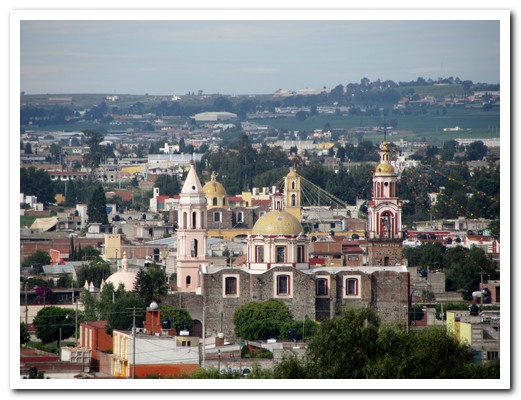
... from on top of the pyramid
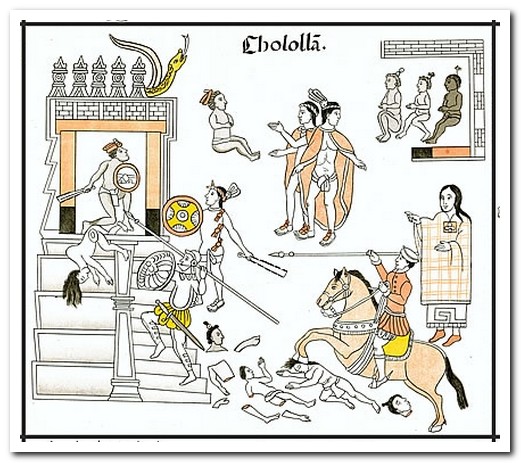
The Lienzo (Canvas) de Tlaxcala, painted 1552, shows the massacre of Cholula
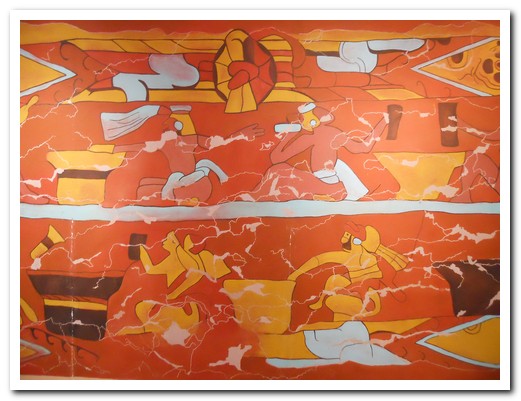
Mural of the drinkers found on a temple inside the pyramid
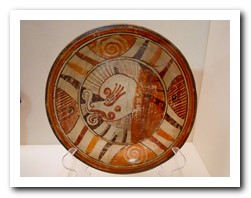 |
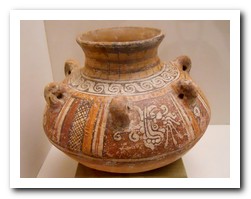 |
| Cholula pottery from about 1000 AD |

Moorish looking Convento San Gabriel is one of the oldest in America, 1549

Capilla Real with 49 domes, late 16 th century
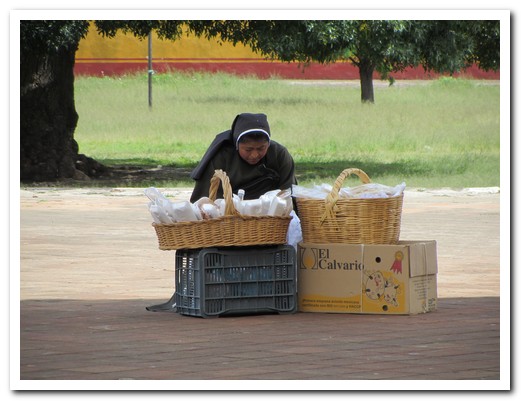
Nun selling delicious biscuits outside the Convento
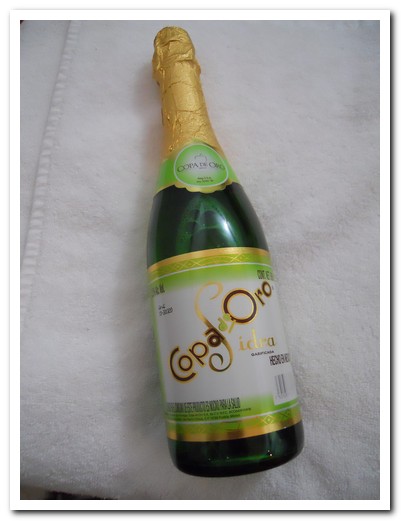
Copa de Oro (glass of gold) cider from Cholula - tastes great

Hill top Santuario del la Virgen de Ocotlán in Tlaxcala - one of México´s important religious sites

San Nicolas Chapel, Tlaxcala

Templo de Santisima Trinidad

Paroquia San José
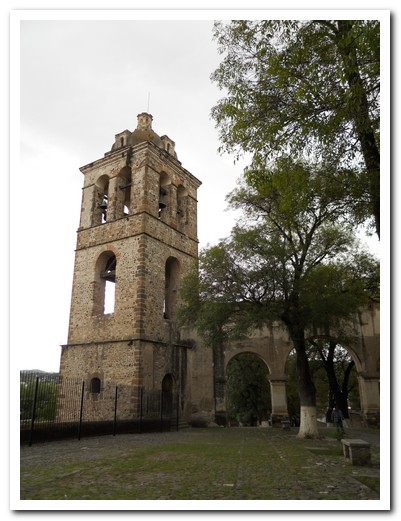
Tower of the Tlaxcala Cathedral
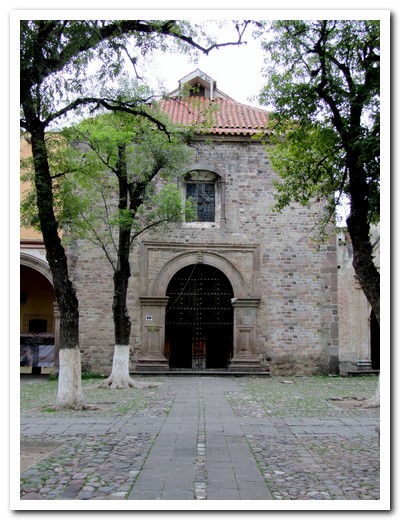
The Cathedral (1537) has an austere Franciscan facade ...

... inside the most beautiful wooden Mudéjar ceiling ...
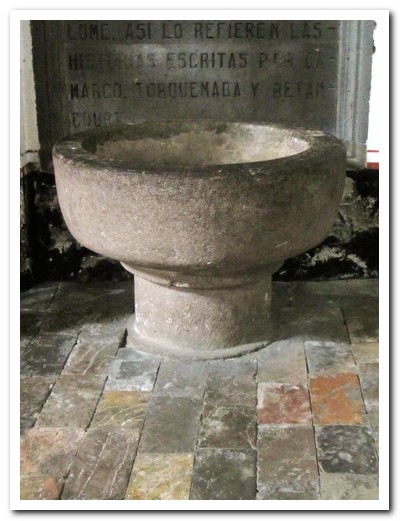
... and the font where the Lords of Tlaxcala were baptised in 1520
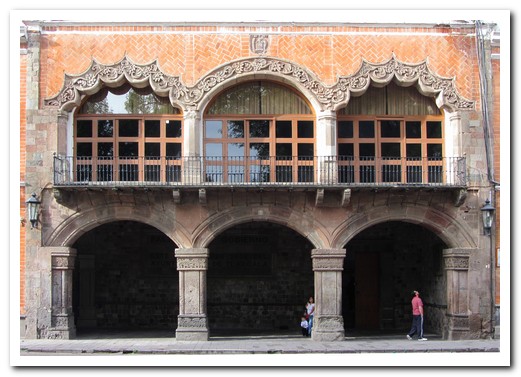
Moorish style doorway

Tlaxcala´s Plaza de Torros (Bull Ring)
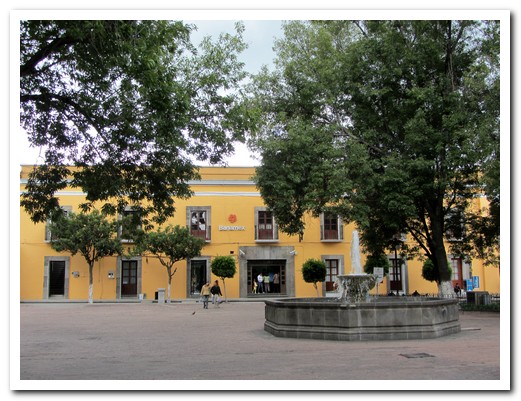
Shady plaza in Tlaxcala

Battle mural of 2 warrior groups, dating before 700AD ...
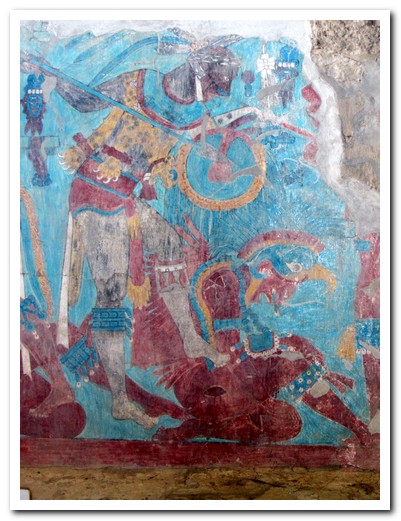
... at Cacaxtla

Eagle warrior mural, Cacaxtla

Ornate urn from the site was used to store seeds
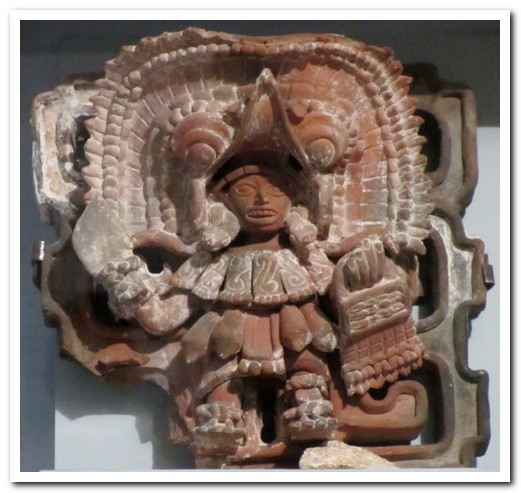
Clay sculpture
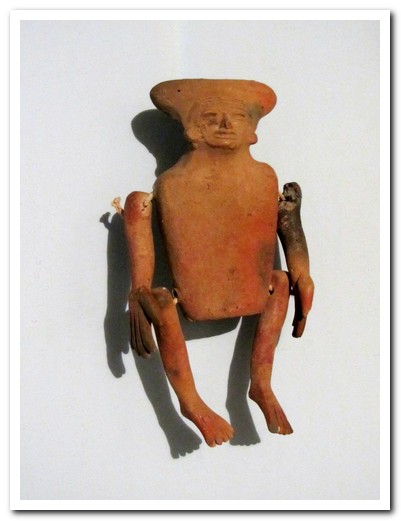
Clay figure with moving arms and legs from Cacaxtla
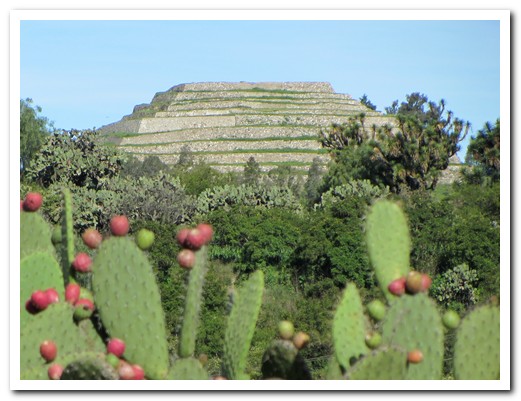
Pyramid on the next hill - the Xochitécatl site
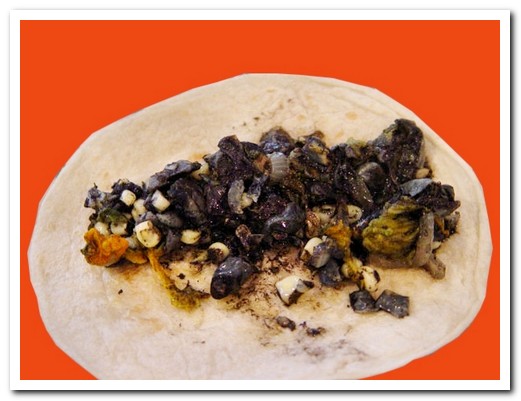
Lunch of corn fungus on tortillas